

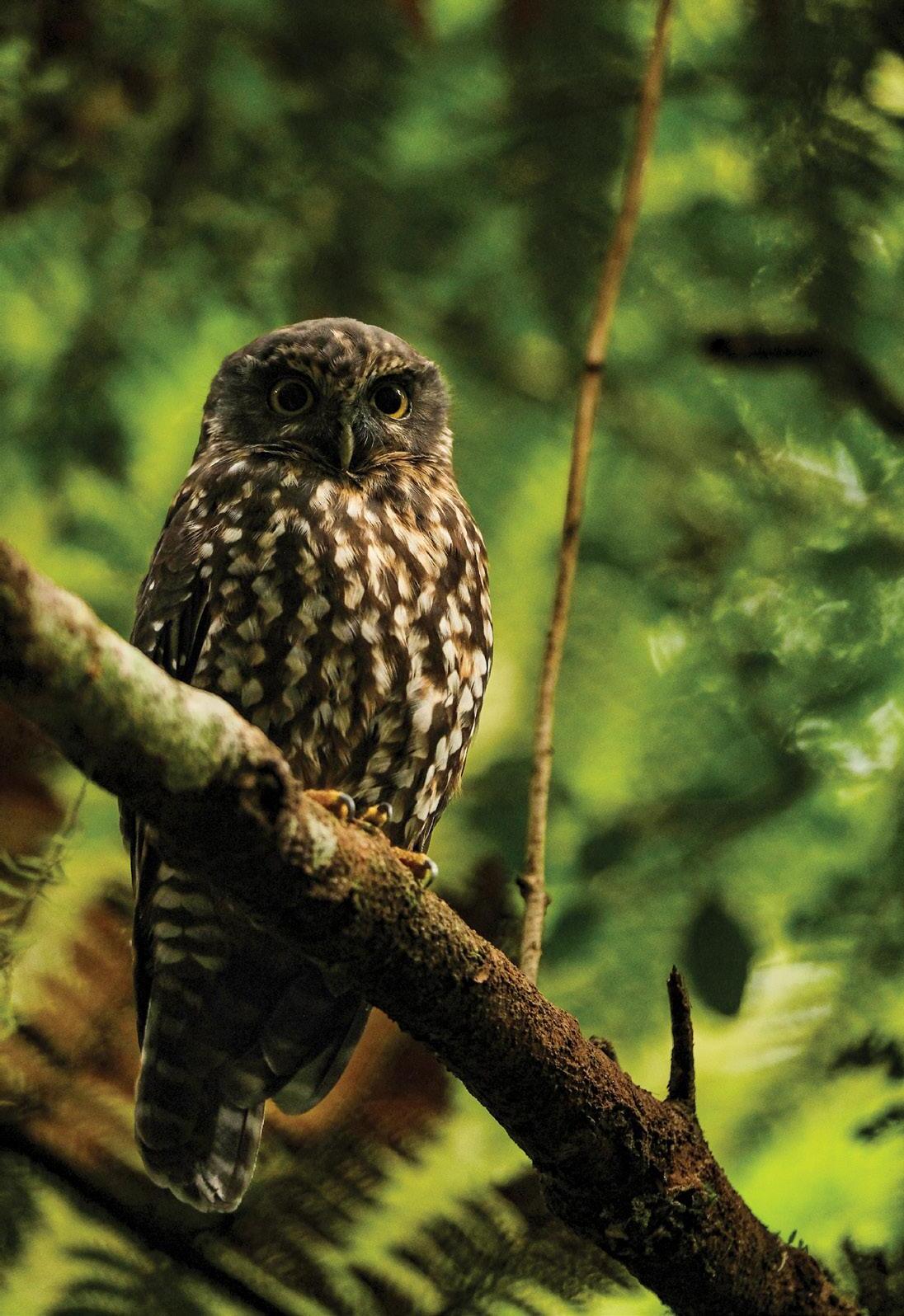
Our 2023 Results
Collectively we’re stronger!
We Ask:
Why is the BCA cadet programme so succesful?
Galapagos to Maketū
Julian Fitter: What a journey so far 30-Years Mahi
Graeme & Carmel
Kaharoa Forest
Their inspirational stories
Inside: Hear from our member groups Top tips for improving outcomes Plus much more...

Incorporated Society & Registered Charity. Founded in 2017

Founded by community, for community Driven to change the paradigm for community-led conservation
‘Lightening the load on our member groups, so they can get on with the real work.’
Now more than ever we need to restore our natural environment, to provide positive well-being outcomes for all. BCA recognises that to achieve our vision it is essential to work collaboratively with government, both local and central, business, funders, iwi and other community partners.
Our role is to strengthen the collective contribution to restoring biodiversity, through collaborative partnerships.
Our strategy and focus is shaped by the size of the biodiversity challenge, the additional problems caused by climate change, an aging volunteer force, an increasing administrative and bureaucratic burden, and the drive to bring more community groups within our support network.
Our alliance members value the support services we provide (administration, fundraising, training, advocacy etc.) to better enable them to do more of the things they love - restoring biodiversity.
Our Vision
Through collaboration the natural ecosystems and indigenous biodiversity of the Bay of Plenty are restored.
Our Purpose:
To support and grow the capability and impact of our communities and partners, to restore and preserve natural ecosystems and indigenous biodiversity.
Our Aims
1. To expand and strengthen the support services for our network members.
2. To grow and develop the Bay of Plenty conservation volunteer base.
3 To improve the capability and impact of the community conservation network.
4. To support and strengthen relationships with our partners.
5. To support landscape-scale biodiversity restoration projects.
6. To improve the sustainability of the BCA network.
Our Services:
These are our key shared support service areas with the intention of lightening the load on our member groups so they can get on with the real work:
• Project/operations management support
• Collaboration
• Education & training
• Communications & marketing
• Fundraising
• Financial management
• Administration
• Advocacy
We hope you enjoy this magazine To find out more about BCA go to
www.bayconservation.nz



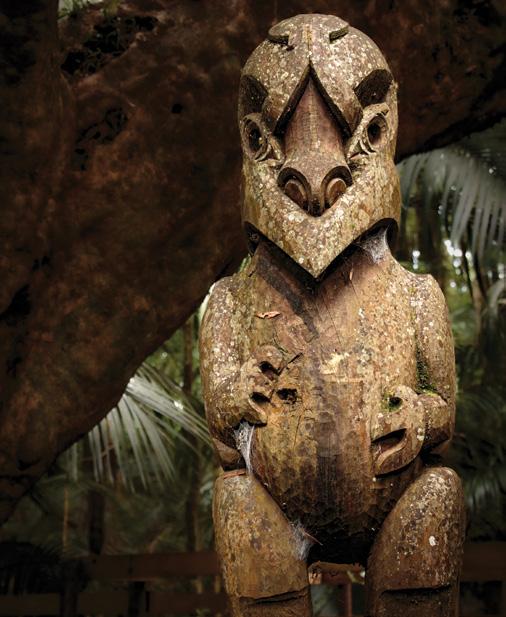
LOOKING BACK ON 2023 3 Galapagos to Maketū Julian Fitter: What a journey so far 30-Years Mahi Graeme & Carmel Kaharoa Forest Their inspirational stories We Ask: Why is the BCA cadet programme so succesful? Our 2023 Results Collectively we’re stronger! Inside: Hear from our member groups Top tips for improving outcomes Plus much more... Bay Conservation Alliance - Who are we? 2 A word from our Chair, Julian Fitter 4 Meet the team 5 News 6 Member Groups & Collective Results 8 Feature: Julian Fitter 11 His journey from Galapagos to Maketū Feature: Thirty years of dedication 16 Carmel Richardson & Graeme Young BCA’s cadet programme: Why is it unique? 20 Janie expains the Nature Education programme 22 Myrtle Rust: Rotoiti 15 Trust fights back 24 What you need to know about dogs & kiwi 25 End of year finacial report 51 Aongatete Forest Project 26 Aongatete Outdoor Education Centre 27 ARRC Wildlife Trust 28 Matatā Conservation Care Group 29 Friends of Tarawera Trail 30 Friends of the Blade 31 Halo Whakātane ................................................................................... 32 Hukutaia Domain Care Group 33 Kopurererua Valley Rotary Centennial Trust 34 Kaharoa Kōkako Trust........................................................................ 35 KEEP (Kōkako Ecological Expansion Programme) 36 Rotoiti 15 Trust 37 Maketū Ōngātoro Wetland Society 38 Manawahe Eco Trust 40 PIPS 41 Mokaihaha Kōkako Trust 42 Motu Trails Trust 43 Ōtanewainuku Kiwi Trust ................................................................. 44 Te Whakakaha Trust 45 Project Parore (Uretara Estuary Managers) 46 Waitao Landcare Group ................................................................... 47 WETA Project 48 Whakatāne Kiwi Trust 49 Western Bay Wildlife Trust 50 Real Creative Media Ltd Design & Publication Management Clare Power clare@realcreative.co.nz COVER: This beautiful photo was taken by Josh Ferguson. Check out his other photos on Instagramm @Chasing.the.wilderness Our Stories Our People Member Group News & Information 26-50 P. 33 - Hukutaia Domain Care Group News
This Issue Special thanks go to former cadet Clare Power for writing, designing and producing our new look annual collective impact story. We hope you enjoy it!
Photo credit: Wayne O’Keefe
The Long-term Benefits of
Investing in Conservation
Healthier Country | Stronger Economy
Our native species are specifically adapted to the Aotearoa of 1000 years ago, before the arrival of Homo sapiens. They are ill-equipped to handle the twin attacks from invasive species and climate change.
In contrast, most introduced pest species are extremely adaptable to change. They are survivors.
I have been involved in environmental conservation in Aotearoa New Zealand for the past 15 years, and in that time, I have never seen as many challenges as we face today.
We work hard to protect our native
shows quite conclusively that a healthy conservation estate is a key contributor to our nation’s economy and our well-being. Additionally, a significant number of tourists come here to visit our native forests, alpine areas, wetlands, dunelands, estuaries, and lakes, spending time in DOC-managed land, and the tourism sector generates 20% of our export earnings - $16 billion!
‘The Value of Conservation’ (DOC, 2006) shows quite conclusively that a healthy conservation estate is a key contributor to our nation’s economy & our well-being.
species from these adaptable invasive pests – be they rats, possums, or pampas –and sure, we have made progress in some areas. However, if you look at the bigger picture, we are still going backward. The pests are winning, and this is not just due to climate change.
WORTH INVESTING
DOC has stewardship of 30% of Aotearoa New Zealand. To fulfill all its statutory responsibilities, the Government allocated a budget of $710 million for 2023/24. (This amount includes ringfenced Jobs for Nature funding.) $710 million represents only 0.44% of the Government’s overall expenditure of $161 billion. DOC is starved of funds.
And yet, ‘The Value of Conservation’ (Department of Conservation, 2006)
Any switched-on businessperson - and I expect our current Prime Minister would regard himself as such - would see that an investment in conservation would pay significant dividends.
BRIDGING THE GAP
Many organisations like Bay Conservation Alliance have been set up to try and bridge the gap caused by the Government’s under-funding. The coming years will be difficult for BCA, along with other conservation organisations scattered throughout the country. We are going to have to find ingenious and effective ways to raise funds to do the work that - in all fairness - is the responsibility of central government, supported by local councils. BCA’s Board and Executive will be strongly
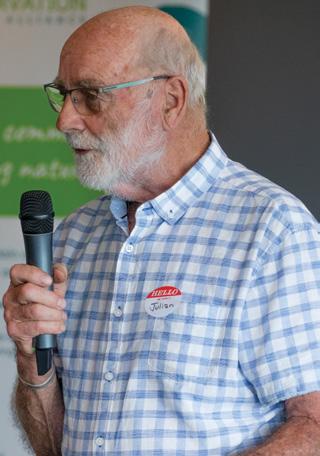
focused on developing new and varied sources of funding. At the same time, we will work with politicians to try and improve the current situation.
WE INVITE YOU TO INVEST FOR THE FUTURE
Leaving a bequest to Bay Conservation Alliance in your will is a wonderful way to support conservation in New Zealand for future generations. Legacies provide ongoing funding for our organisation and enable us to plan ahead and commit to long term plans.
We have set up an endowment fund with the Acorn Foundation, as we believe this provides professional management and certainty for everyone concerned. Click the QR code to find out more.
MY THANKS
Michelle Elborn, BCA Chief Executive, along with Emma Cronin, Wayne O’Keefe, Kim Saunders, Claire Hartley, Emma Richardson, Thomas Knight and Janie Stevenson, have done an amazing job in keeping us at the forefront of the Bay of Plenty conservation story. My thanks to them and my fellow board members for their tremendous input.
Julian Fitter, CHAIR Bay Conservation Alliance
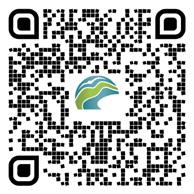
4 WWW.BAYCONSERVATION.NZ P 07 808 0710
ABOVE: Bay Conservation Alliance Chair Julian Fitter discussing the year that was, to a packed house at B.C.A.’s 2023 AGM.
RIGHT: Leaving a bequest to Bay Conservation Alliance in your will is a wonderful way to support conservation in New Zealand for future generations. Click the QR code to find out more.
A WORD FROM THE CHAIR
Stuart Attwood
MEET THE TEAM
The Team
Bay Conservation Alliance


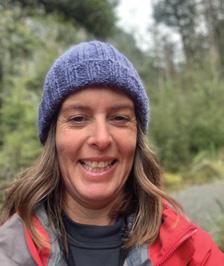

Michelle Elborn
Chief Executive Officer
michelle@bayconservation.nz
Michelle has the responsibility of supporting the team, keeping everything on track, applying for funding, delivering strategic objectives, overseeing communications & more. She loves escaping the office to join volunteers, cadets or schools!
Janie Stevenson
Education & Engagement Manager
education@bayconservation.nz
Janie is the BCA Education and Engagement Manager. She is usually found with students out exploring our incredible local taiao from the mountains to the sea.
Emma Richardson
Programme Educator
cadets@bayconservation.nz
A marine & fresh water scientist, Emma is passionate about conservation education and keeps motivated by the deep change in people, as they connect with the environment in a meaningful way.
Claire Hartley
claire@bayconservation.nz
Claire looks after BCA’s online social media platforms & website. When not busy with that she helps with administration jobs for the cadet programme and other office tasks.
Emma Cronin
Operations Manager WBOP
emma@bayconservation.nz
Emma liaises with member groups to help optimise outcomes from their mahi. She’s a great person to contact for advice about monitoring, pest control and help with using Field Maps.
Wayne O’Keefe
Operations Manager, EBOP
wayne@bayconservation.nz
Wayne liaises with member groups to help optimise outcomes from their mahi. He’s a big picture thinker, passionate about trees & vegetation, & happy to share his knowledge with your group.
Thomas Knight
Cadet Programme Educator
cadets@bayconservation.nz
Bird & biology lover, Thomas is a walking encyclopedia. His infectious enthusiasm & broad knowledge base has been valued by every BCA Cadet within the programme.
Kim Saunders
Finance & Admin Coordinator
finance@bayconservation.nz
Kim is the one that “torments” the team for receipts & invoices! Along with looking after payroll & accounts she helps with all the day-to-day comings & goings in the BCA office!
Bay Conservation Alliance Board Members
CHAIR: Julian Fitter
SECRETARY: David Peters
TREASURER: Clive Lock
2023 BOARD MEMBERS:
Alice Cameron
Tim Short
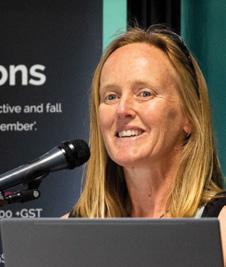



Mark Dean
Anna Wentsch
William Anaru
LOOKING BACK ON 2023 5
Project Support Coordinator
Cadet
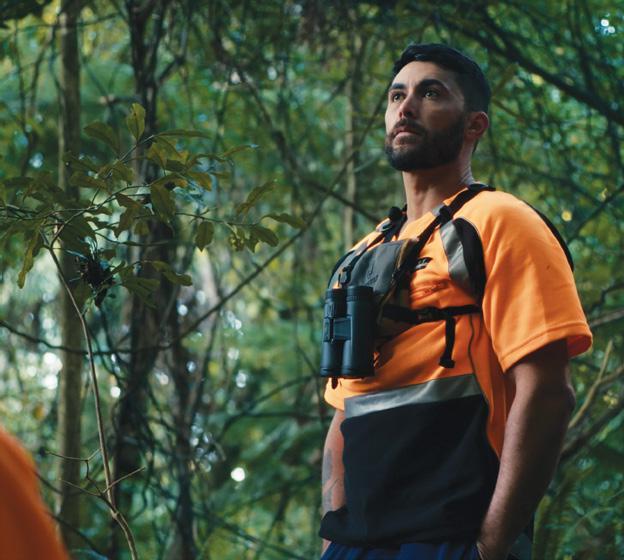

THE TURNING POINT PAORA
A HUNTER TURNED TRAPPER
USE GAME CAMERAS TO UP YOUR GAME!
GAME CAMERAS ARE AN INTEGRAL TOOL for understanding how pests are interacting with traps. They enable us to try different baits/lures, to see where the bait is completely ignored and where they show some interest. For trap-shy feral cats this information is so valuable! Member Group: Friends of the Blade
START SMALL BUT ALWAYS THINK BIG!
OUR STRENGTH IS AS A COLLECTIVE, not as individuals. Look for opportunities to connect and collaborate. Find out about nearby projects, talk to your neighbours - you may be surprised by the conservation community that already exists on your doorstep.
BCA Operations Manager: Wayne O’Keefe
MAKE ACCESS EASY!
GET RID OF ROADBLOCKS stopping pests getting access to bait. Try adding a rope to your bait stations so that rats can easily climb to the stations.
Member Group: Ōtanewainuku Kiwi Trust
MAKE A START AT HOME!
The easiest way to get involved in conservation is to become a backyard trapper. Not only will this stop pests coming into your home, you’ll also support the environment beyond your gate.
Member Group: HALO
Last year Bay Conservation were approached to be included in a new RNZ documentary series called The Turning Point. The series follows a new generation of kaitiaki as they take on the challenge of protecting and restoring our natural environment.
A recently graduated cadet’s story came to mind for us and in March 2023, we had fun hosting Ocular, the Wellington-based film crew. Paora McAllister had lost his business due to Covid. During this time he became engaged in his Iwi’s (Tapuika Iwi Authority), aspirations for taiao (environmental) work.
This led Paora and Rawiri Faulkner to join our Bay Conservation Cadets - Tauira Mahi Intake Six training programme.
After graduating he returned to Tapuika where he is now team leader. We will give no more spoilers as this is simply a must watch,
Scan QR code to watch:

REMEMBER BIGGER IS NOT ALWAYS BETTER
ALTHOUGH IT MAY BE TEMPTING TO BUY BIGGER, better-looking plants for re-vegetation work, think ‘forestry grade’ instead. We’ve found this gives you the best bang for your buck. They are easier to plant, less likely to sulk for the first season and certainly more cost effective.
Member Group: Project Parore
USE BLOODY FRESH RABBIT
BEFORE GOING OUT TO SET YOUR TRAPS, get your hands on a fresh rabbit! They can even be picked up off the road and used, so long as it is fresh! Rub the carcase on both entrances of the trap, drag it around on a piece of rope. Bloody fresh rabbit is good!
Member Group: Te Whakakaha Trust
VALUE COMMUNITY INPUT
HOLD THE ODD CASUAL GET-TOGETHER
for committee/group members, volunteers and partners. It’s a great way to get to know each other and a chance to let people know how much you value their input. Casual conversations can sometimes even lead to effective solutions for challenges you may be facing within a project.
Member Group: Matatā Conservation Care Group
ALLOW FOR NATURAL DEVELOPMENT
MUCH EMPHASIS IS PLACED ON PLANTING native plants. This is important, but once you have a variety of natives established, if you just control the weeds, you will find that Papatuanuku will do the rest. Birds and the wind spread seeds, and if they develop naturally, then they obviously like it there. This is very cost effective as we know from experience that we tend to plant too many trees, too close together and that a significant number fail!
Member Group: MOWS
6 WWW.BAYCONSERVATION.NZ P 07 808 0710 NEWS & TOP TIPS
Photo credit: Luke Frater

2023 Outstanding Contributions To Conservation
In November 2023, we were delighted to bring together so many member group trustees, volunteers and staff for our end of year gathering. A highlight for our event was the recognition of some special volunteers through the presentation of “Outstanding contributions to conservation” awards. Below are the champions for 2023.
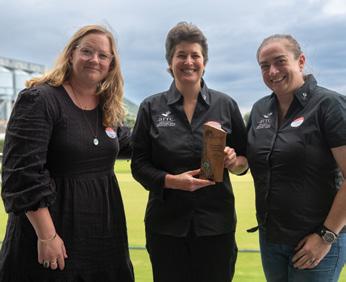
GRAEME
LIZA SCHNEIDER – ARRC WILDLIFE TRUST
Founded by Liza, ARRC celebrated their 20th anniversary this year, a real milestone. ARRC have made countless rescues (14,000 natives animals over the 20 years) and contributed hundreds of thousands of rehabilitation hours towards injured wildlife, including supporting local volunteer foster families with wildlife rehab and liaising with other BOP community conservation groups and events. ARRC also focuses on the need for education to inform our community of the importance of our wild spaces and species.
As well as their usual wildlife work, this year ARRC have initiated a soft release aviary to house native birds prior to their return to their natural habitat, this is in conjunction with BCA member groups Aongatete Outdoor Education Centre and Aongatete Forest Project. They have also added to their children’s book series with the recent publication of ‘Zig and Zag’s Dotterel Dance’, in association with WETA, in Waihi Beach. Wow, congratulations Liza and the ARRC team.
YOUNG AND CARMEL RICHARDSON – KAHAROA KŌKAKO TRUST
This joint award went to two people who probably need no introduction to most in the community conservation sector across the BOP. As a couple they form the perfect partnership; her yin to his yang; her sweet to his salty! Over the years, they have spent countless hours supporting the conservation of our unique taonga species and the preservation of their habitat. However, they are probably best known for the 30 years of dedicated involvement with the Kaharoa Kōkako Trust. Recently, they were instrumental in the formation of KEEP, an ambitious, multi-generational project to connect isolated kōkako populations in the Bay. Always open to sharing their knowledge, both committing incredible volunteer hours weekly – Graeme and Carmel thank you for all that you do.

CLIVE TOZER – WHAKATANE KIWI TRUST

In the work we do, we all know of individuals who contribute greatly, but somehow chose to fly under the radar, unrecognised.
Clive has been actively involved with the Whakatane Kiwi Trust since 2009 and in that time has been a stalwart in supporting many aspects of this complex and nuanced project. He is someone who always turns up when there is bait to be chopped up, is a valued guide on our kiwi night walks, and a dedicated Trustee who has been instrumental in recent negotiations with the kiwi project partners to determine the course of action for the next five years. Clive, a very special thank you for your great contributions. Your team value you so much.

Watching Iwi Capability Thrive
One of the highlights we’ve witnessed thanks to Jobs for Nature funding over the last few years has been the ability of many different iwi and hapū to grow their own capability and determine their own appropriate priorities and actions to restore the whenua.
We are incredibly lucky to have two very significant iwi led landscape scale projects underway in the Bay of Plenty – the Ruakumara Pae Maunga project and the Manaaki Kaimai Mamaku Trust. Both of these projects have spent significant time assessing the challenges these landscapes face and working out action-based solutions. The opportunity to explore and reconnect with whakapapa is instrumental and Māori naturally think and plan with an intergenerational view.
Please take the time to check out these important projects: Raukumara Restoration: Raukūmara Pae Maunga, Te Kaha.
Facebook: @KoTeRaukumaraTeNgahere
Website: www.raukumara.org.nz
Manaaki Kaimai Mamaku: Website: www.mkm.org.nz
LOOKING BACK ON 2023 7 CONSERVATION ALLIANCE BAY
Turn
to pp 16 & 35 for more information
Turn
to p.49 for more information
Turn to p28 for more
information
Photos: Stuart Attwood

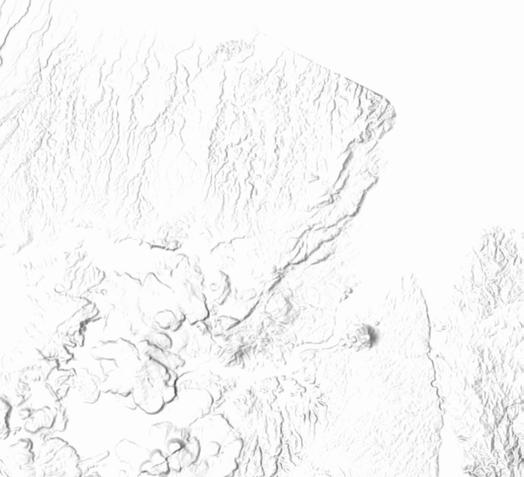











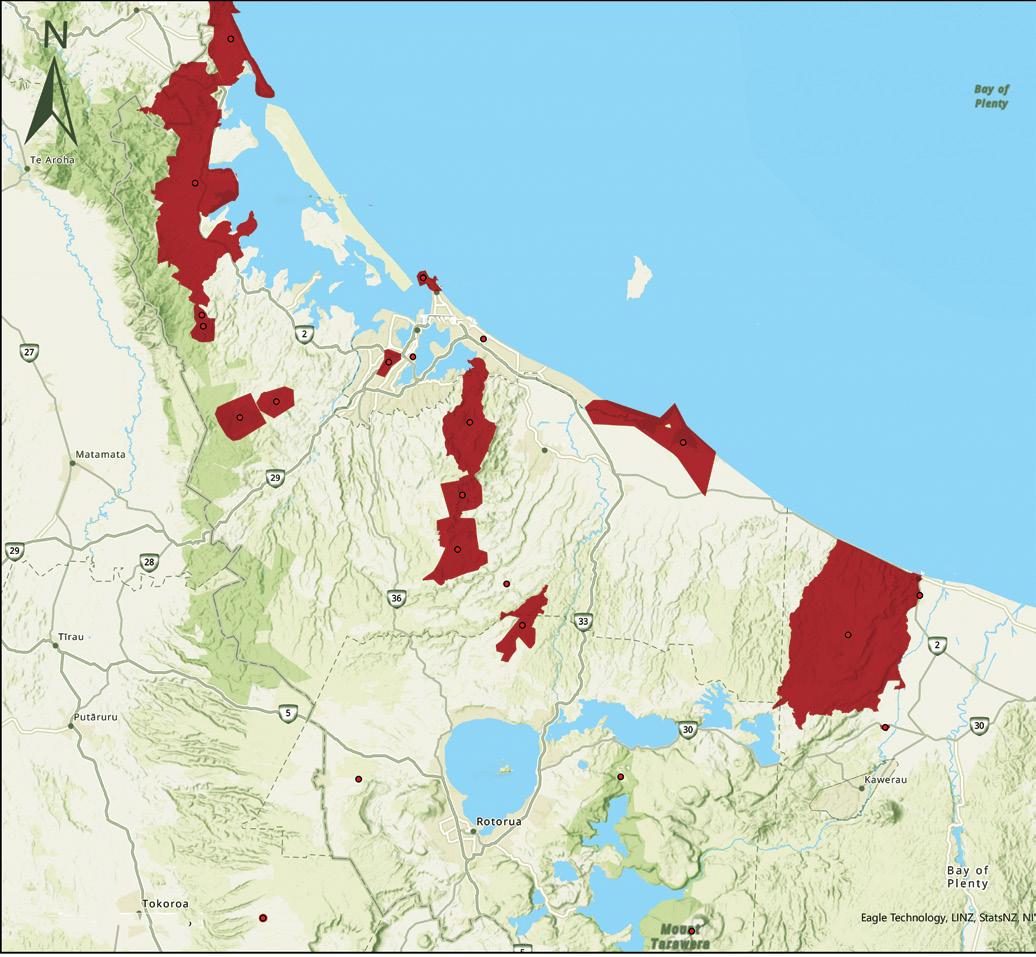

8 WWW.BAYCONSERVATION.NZ P 07 808 0710 OUR YEAR IN NUMBERS Tauranga Matata . . Rotorua . . . . . . . . . Individual Volunteers 885 42,483 2023 Hours worked OUR COLLECTIVE IMPACT OUR COLLECTIVE REACH CONTINUES ON OPPOSITE PAGE 30 33 Kawerau 30 35 2 Bayof Plenty Eagle Technology, LINZ, StatsNZ, NIWA, Natural Earth, © OpenStreetMap contributors., Eagle Technology, Land Information New Zealand 0 10 20 5 Kilometers Auckland Eagle Technology, LINZ, StatsNZ, NIWA, Natural Earth, © OpenStreetMap contributors., Eagle Technology, Land Information New Zealand Date Exported: 2/02/2024 Conservation Alliance Project Areas 2024 Scale: 1:400,000 MAP SCALE: 1:400,000 (KM) Bay of Plenty PAGE 13 2023 Results are based on 21 of the 28 Member Groups*
12,015 Pests recorded as Trapped or hunted
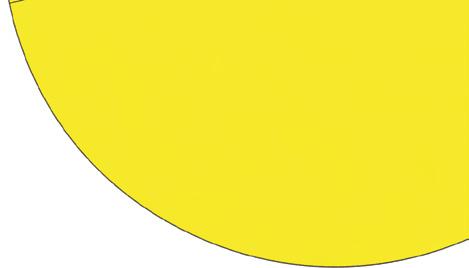
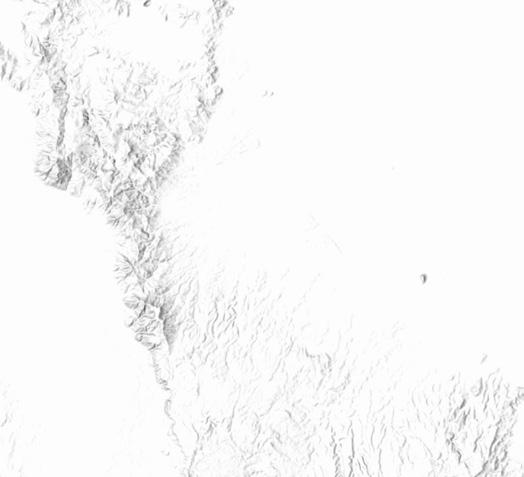


Natives trees planted

Hedgehogs, mustelid & *other 4% 3% 3%3% Mice
Possum 22%
53,386

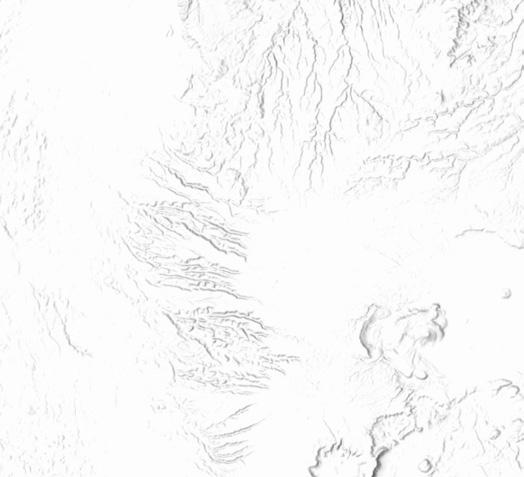
172 Days Monitoring Species Levels


339 Days Teaching Conservation

698 Injured Wildlife Rehabilitated





Rats 66%

KEY: PEST SPECIES
Mice
Other Possum Rat Mustelid
Hedgehog


*Other includes rabbit, wallaby, pigs, feral cats, magpies, deer & goat
*FIGURES BASED ON DATA FROM THE FOLLOWING
GROUPS: BCA Member groups are asked to send BCA total pests caught, volunteer numbers and volunteer hours for the year. Not all members sent in results, so this represents 21 out of 28 groups. Pest breakdown is an approximate only. Results from baiting are not included.

Bay Conservation Alliance Project Areas 2024
Scale: 1:400,000
MAP SCALE: 1:400,000 (KM) .
KEY .
PROJECT AREAS
INDIVIDUAL GROUPS
See map on page 10 for more information and details
Bay of Plenty towns and cities
MAPPING:
Eagle Technology, LINZ, StatsNZ, NIWA, Natural Earth.
©OpenStreetMap Contributors, Eagle Technology , Land Information New Zealand
Spatial Reference
Name: NZGD 2000 New Zealand Transverse Mercator
PCS: NZGD 2000 New Zealand Transverse Mercator
GCS: GCS NZGD 2000 Datum: NZGD 2000
Projection: Transverse Mercator
Central Meridian: 173.0000
LOOKING BACK ON 2023 9
Whakatane Opotiki . . . . . . . . . . . . 30 36 33 29 5 5 Kawerau Rotorua 30 2 Bayof Plenty Eagle Technology, LINZ, StatsNZ, NIWA, Natural Earth, © OpenStreetMap contributors., Eagle Technology, Land 0 10 20 5 Kilometers Auckland Eagle Technology, StatsNZ, NIWA, OpenStreetMap Technology, Land Date
Transverse Mercator Transverse Mercator
72%
CONTINUES ON OPPOSITE PAGE
COLLECTIVE REACH CONTINUES ...
OUR

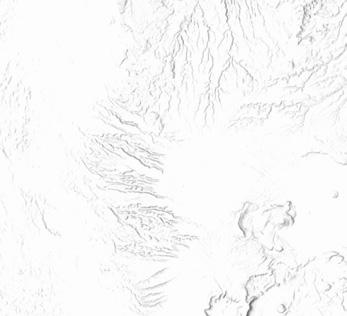





10 WWW.BAYCONSERVATION.NZ P 07 808 0710 MEMBER GROUPS Aongatete Forest Project P. 26 Aongatete Outdoor Education Centre P. 27 ARRC Wildlife Trust P. 28 Canopy Conservation Trust Friends of Tarawera Trail P. 30 Friends of the Blade P. 31 Halo Whakātane P. 32 Hukutaia Domain Care Group P. 33 Kopurererua Valley Centennial Trust P. 34 Kaharoa Kōkako Trust P. 35 KEEP Rotoiti 15 MOWS (Maketū Ōngātoro Wetland Society) Manawahe Eco Trust Matatā Conservation Care Group P. 29 Mokaihaha Kōkako Trust P. 42 Motu Trails Trust P. 43 Ōtanewainuku Kiwi Trust P. 44 PiPs P. 41 Project Parore P. 46 Te Whakakaha Trust P. 45 Project WETA P. 48 Waitao Landcare Group P. 47 Western Bay Wildlife Trust P. 50 KATIKATI WAIHI TAURANGA MT MAUNGANUI TE PUKE ROTORUA Project WETA Project Parore Western Bay Wildlife Trust Aongatete Outdoor Education Centre Aongatete Forest Project Friends of the Blade Oteora Trust PIPs Waitao Kaiate Landcare Group Te Whakakaha Ōtanewainuku Kiwi Trust KEEP Kaharoa Kokako Trust Canopy Conservation Trust Mokaihaha Kokako Trust Rotoiti 15 Trust Whakātane Kiwi Trust Domain Upukorehe Kiwi Project Friends of Tarawera Trail 1. ARRC Wildlife Trust 2. Kopurererua Valley Centennial Trust 1 2 Name: NZGD 2000 New Zealand Transverse Mercator PCS: NZGD 2000 New Zealand Transverse Mercator Eagle Technology, LINZ, StatsNZ, NIWA, Natural Earth. ©OpenStreetMap Contributors, Eagle Technology, Land Information New Zealand Paeroa TeAroha 27 29 Matamata Tīrau Putāruru 30 28 36 33 29 2 5 5 Mount Maunganui Kawerau Rotorua Tokoroa 30 2 Bayof Plenty Eagle Technology, LINZ, StatsNZ, NIWA, ± 0 10 20 5 Kilometers Bay Conservation Alliance Project Areas Scale: 1:400,000 Spatial Reference Name: NZGD 2000 New Zealand Transverse Mercator PCS: NZGD 2000 New Zealand Transverse Mercator GCS: GCS NZGD 2000 Datum: NZGD 2000 Projection: Transverse Mercator Central Meridian: 173.0000 MAP SCALE: 1:400,000 (KM)
Conservation Alliance’s Member Group & Locations BCA understands the challenges you face Scan the code to find out more Group Name More Info Group Name More Info IT’S NOT EASY PROTECTING OUR WHENUA IN 2024 2023 We are here to help you Together, we are stronger To see how we can help, please turn to page two of this magazine or head to our website For $100 per year your group can become a BCA Member
Bay
Julian Fitter: From Galapagos to Maketū

Julian Fitter was a founding member of Maketū Ōngātoro Wetland Society (MOWS), and last year, after 14 years, stepped down as their Chair. Clare Power met with him over coffee to talk about his life and his time with MOWS.
Julian Fitter has had, what can only be described as a fascinating and varied life thus far. Born and raised in England, his interests are in biology, geography, and economics. His parents were leading conservationists and both wrote - his mother a journalist his father a naturalist and writer
Julian left England in 1964 to sail to Galapagos as a crew member on the Charles Darwin Foundation ship SV. Beagle. In 1965 he married Mary Angermeyer, whose father Carl had emigrated to Galapagos from Germany in 1935. He stayed for four years before returning to England to buy a 46ft Bermudan rigged cutter, with the idea of setting up a tourism business in Galapagos. A year later he sailed it back to Galapagos with his young family onboard, and over the years the business grew, and one yacht became four. He sold his business in the late seventies and the family returned to England. The initial intent had been to set up a tourism venture in the Falkland Islands, but that failed – had it kept going he would have been caught up in the invasion of the islands by Argentina in 1982!
Julian then worked in finance, and in 1984 he developed an independent financial advice business called Julian Fitter Associates, which in time became part of Savoy Financial Planning Plc. He remained
with the company until 2004.
In 1979 he helped set up a UK charity, Falklands Conservation and was a founder trustee. Four decades on, he is still a member, currently one of the Vice Presidents—a role he shares with Sir David Attenborough!
He is also an Ambassador for the Galapagos Conservation Trust and was instrumental in its development in 1997. Once founded he held the role of Chair. There is so much more to say about Julian’s life so far, and it is well worth visiting his website www.julianfitter.co.nz.
I would describe Julian as part entrepreneur, part conservationist. This, combined with decades of life experience, unstoppable energy, and his vision for conservation work in New Zealand has had a positive impact in the Bay of Plenty.
MOWS (Maketū Ōngātoro Wetland
Society) is a conservation group that was founded in 2009 and works to conserve, protect, and restore the natural ecosystem and native biodiversity of the lower Kaituna River, Maketū Estuary, Waihi Estuary, and the surrounding areas in the Bay of Plenty.
LOOKING BACK ON 2023 11
BAY CONSERVATION ALLIANCE
ABOVE: Julian in discussion with an immature Tristan Albatross Diomedea dabbenema, a species whose survival is threatened by mice. (Gough Island.)
Photo credit: Tui DeRoy

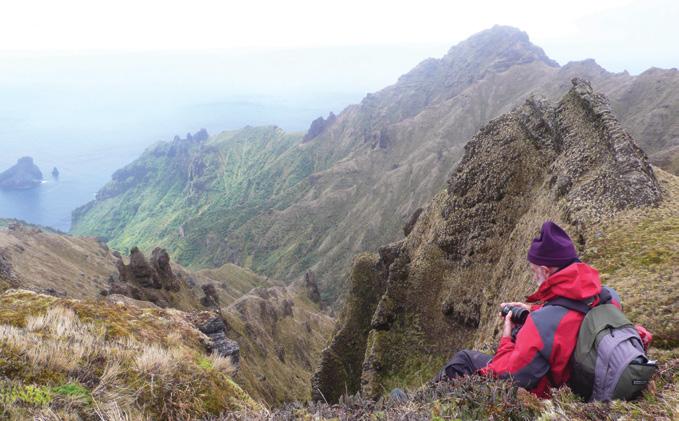
Julian is currently one of the Vice Presidents of Falkland Conservation Trusta role he shares with Sir David Attenborough!
BUT HOW DID JULIAN END UP IN NEW ZEALAND?
In the 70s while living in Galapagos, his Belgian neighbours had a daughter who worked as a guide on one of his tourist boats. Her name was Tui De Roy. Over the years that followed they kept in touch as she travelled the world working as a wildlife photographer. In the early 2000’s he travelled to New Zealand and joined her and Mark Jones, and together they researched and wrote the book, Albatross: Their World, Their Ways. (Bateman 2008)
During this time Tui’s publishing agent at Batemans approached him to see if he was interested in writing a guide to New Zealand’s wildlife, similar to the book he had already published with Harper Collins in 2000 called Wildlife of the Galapagos. He agreed, and in doing so he visited many wild places on the mainland, as well as offshore islands such as the Antipodes and the Chatham’s. The book, A Field Guide to Wild New Zealand, was published in 2002 followed by Birds of New Zealand (Harper Collins 2011) and Julian, having seen more of the country than most residents, was very keen to stay.
“Galapagos Islands are well noted for their high levels of endemicity - as in species that are only found in the Galapagos,” Julian explains. “Think of marine iguanas, Darwin’s finches and the like. So, there is an instant link to New Zealand, except that New Zealand has a higher percentage of endemic species than Galapagos.”
to feed on the ground!”
Julian spent the next few years visiting New Zealand, travelling extensively as he wrote and got, what he described as, “a very good handle on the place”.
UK TO MAKETŪ
By 2007 Julian was in New Zealand, having settled in Wellington with his artist friend Jayne Ivimey. After about a year they decided that warmer climes would suit them better and Jayne wanted a less European’ environment! After returning from a road trip around the North Island, they saw a house for rent in a place called Maketū. Unsure where this was, they looked it up and realised they had stopped there for a brownie and coffee and thought it was lovely at the time. They contacted the owner, Bay of Plenty photographer Andy Belcher, and after a quick trip back up the island they signed up and moved in January 2008.
DOTTEREL AND STOLEN PIGTAILS
“My move into conservation has been a slow journey,” explains Julian. “I’ve been involved for a long time, but more on the governance side of things, with the Galapagos Conservation Trust and Falklands Conservation,
ABOVE: (L & R): Gough Island - one of the most remote islands in the world. Julian was lucky enough to get the chance to explore the island with Tui DeRoy as part of their research for their book Albatross, Their World Their Ways.
“Something like 80% of our native species are endemic to New Zealand,” he continues. “And that’s across the whole range from fungi to insects to birds. We have virtually no land mammals anywhere apart from some bats, which actually prefer
Not long after we moved to Maketū, we heard there was to be a local meeting where a guy from Matata would talk about the New Zealand dotterel that nest on the beaches. After the talk everybody agreed that we needed to do something about protecting the dotterel on the spit. So, a fence was erected around the area using pigtail standards, and almost immediately somebody stole the pigtails!”
Thankfully this did not put the locals off.
12 WWW.BAYCONSERVATION.NZ P 07 808 0710 FEATURE STORY: FROM GALAPAGOS TO MAKETŪ
Photo credit: Tui DeRoy

MOWS – 2009-2023 A BRIEF OVERVIEW
By 2009 an informal group, MOWG, was established to protect the thirty-five hectares of dunes at Maketū Spit, and local, Maureen Burgess, was the chair, secretary and treasurer.
“Maureen said that this was too much for one person, so I offered to help and became Chair,” explains Julian.
MOWS has grown considerably since then. In 2010 MOWS signed a Biodiversity Management Plan (BMP) with BOP Regional Council to look after Maketū Spit, then in 2011 they became a society as they needed to be a legal entity to handle funds. In 2013 they signed another BMP for Dotterel Point in Pukehina and then a third, Newdicks Beach in 2014 and a fourth in 2015 with the Waihi Harbour WMR – a 45ha DOC Reserve. Their fifth BMP was initially a Maketū Taiapure project, on the Kaituna River, started by their new Chair, Peter Ellery.
Over time they developed a team of highly skilled and qualified staff. Initially none of them had the skills, but they learnt them and taught others along the way. The key skills needed were pest and weed control, but additionally they had to develop skills in ecological monitoring, planting, infrastructure, fencing and site maintenance. More recently they have been able to contract their services outside the MOWS area to help fund the unfunded running costs.
In 2015 they established an education programme based around teaching children to value and care for the natural environment — be it forest, wetlands or coastal — and they now take this programme to most of the schools in the area.
A lot has happened in a short space of time! For more a more detailed history go to maketuwetlands.org.nz
THE IMPORTANCE OF ADAPTING TO CHANGE
So why has he stepped down as chair for MOWS after 14 successful years?
“I have a sort of unwritten 10-year rule,” says Julian. “Life is about adapting to change. Darwin said that it’s not the strongest or the smartest that survive, it’s those that can adapt to change. One of the few things I remember from school is having a teacher visiting from Eton say to us that one of the most challenging things in life can be managing change. Things change whether you like it or not. I guess my role has changed somewhat, from being very hands-on and doing a lot of the work, to gradually becoming more managerial, a. And now I’m stepping back to allow them to get on with it. I’m still involved in two or three things because we’re in the process of acquiring a wetland. And after 10 years doing a particular thing, it’s not a bad time to pass it over.”
Although Julian planned to exit after 10 years it took another four to set things in place before he was able to step down.
I wanted to know what Julian believed to be the underlying reasons MOWS had experienced such growth in a relatively short amount of time.
PLAN IN DETAIL BEFORE YOU ‘DO’! When they started, BOPRC’s Coast Care looked after dunes along the coast in the Bay of Plenty. The guy on the ground was Pim De Monchy and after seeing the work being done by MOWS on the Spit, he suggested to Julian they should make a BMP. (Biodiversity Management Plan - now called an Environmental Plan.) That would provide secure funding over a five-year period, giving certainty over what they could achieve. In 2010 Julian sat down with Pim for a few hours and at the end of
“We have a higher percentage of endemic species than Galapagos. Some 80% of our native species are endemicfound only here in New Zealand!
ABOVE: Fixing the semi-permanent fence, Dotterel Point, Pukehina
LOOKING BACK ON 2023 13
BAY CONSERVATION ALLIANCE
Photo credit Julian Fitter

it they had a BMP for Maketū Spit. Many BMP’s concentrate on managing specific aspects of the environment in an area, but the MOWS plan was very comprehensive, and funding from regional and district councils and DOC was approved.
“We knew what we were doing, when we were doing it and how we were paying for it, and that was really good.” Julian says.
As MOWS took on new areas, individual BMPs were developed. This detailed planning and funding has been a significant factor in their achievements so far.
To be successful in conservation the planning needs to happen before the funding. How can you know what you need when you don’t know exactly what you will be doing? This seems logical but is not always the case. Far too often funding is released based solely on an idea, and projects can fail due to money being spent without having a long-
*THE RENA DISASTER
The Rena Disaster was an oil spill that occurred off the coast of Tauranga, NZ in October 2011. The spill was caused by the grounding of MV Rena on Astrolabe Reef. It was carrying 1,368 containers, including thirty-two containing hazardous substances and 121 containing perishable foodstuffs.
In total, an estimated 169 containers fell overboard. Also carrying 350 tonnes of Bunker C fuel oil.
term sustainable plan in place. This makes it easier to obtain funding from multiple funders, rather than just one major donor. Work in conservation should result in economic value to the community. One of MOWS’s strengths is that they have grown gradually over the years and have a good reputation for getting results.
“We really wanted to bring the benefits of the conservation work into the community to show that conservation is also good for the local economy. Initially we paid local contractors to do some of the work, but soon decided that if we could train and do the work ourselves, then there would be greater benefit to the community. This this is one of the key things that we wanted to do.” Julian says.
Clearing wilding pines is a relatively expensive activity, with outside contractors charging around $115 per hour. In the early days of the Spit’s BMP Julian contacted Pim with a proposition: “We’ve got quite a lot of money specifically set aside for getting rid of the wilding pines. Rather than spending all this money on outside contractors, why don’t we get the training and do the work ourselves?”
Pim and the other funders agreed. Julian believes that relying on volunteers to get large amounts, of sometimes specialised work done, is both impractical for long term planning and it’s unfair to expect them to regularly turn up and work hard for nothing. Volunteers help, but they tend to come and go and are often only available at weekends. He says that there’s just not the numbers that are needed to do the work,
especially in smaller communities and some work requires skills that they just don’t have. Initially they just contracted some of their members on a casual basis, but then in 2020 they decided to take the plunge and become an employer, giving employees full employment benefits. He says that this is fairer for their workers and of greater benefit to the community.
YOU DON’T KNOW WHAT YOU’VE GOT UNTIL YOU ALMOST LOSE IT
The national response to the *Rena disaster in 2011 was hard to witness. There was a lack of appreciation and understanding at all levels of local and national government. There was a particular lack of appreciation as to the urgency of the situation. Once the oil leaked there was even more confusion Eventually the local community. both in Pāpāmoa - which was hardest hit - and Maketū took over, and with the support of BOP Regional Council they did a pretty good job. Official advice to locals from various authorities was stay away and leave the clean-up to the specialists, but we actually had no specialists.
This community action showed the love locals felt for the area, and their combined grief demonstrated just how important our natural environment is to us as humans.
Sometimes you don’t know what you’ve got, until it is almost taken from you.
THINK SMARTER!
One silver lining from Rena was that funding became available through compensation paid by the shipping company to help with
14 WWW.BAYCONSERVATION.NZ P 07 808 0710
FEATURE STORY: FROM GALAPAGOS TO MAKETŪ
BAY CONSERVATION ALLIANCE

the costs of the clean-up. MOWS was able to get enough funding to purchase their very own side-by-side utility vehicle. This made a massive difference, because up until this time Julian had to drive to and from Mount Maunganui to borrow a Council vehicle, which took precious hours, (and gas money), that could have been better spent in the field. Access to the right equipment such as diggers and side-by-sides save many days of manual labour.
Julian says that a big hindrance to working a new area can be lack of access. “There is no point spending half your time battling to get to a place; people need to be able to get into an area and get the job done. One of the first things to consider when planning a new project is how accessible it is. If there is no easy way in, then the first job on the list should be building suitable tracks for long-term usage.”
However, sometimes you need to prevent vehicle access. To stop dunes eroding and allow vegetation – either planted or naturally regenerating – to thrive, vehicle access needs to be restricted. MOWS struggled in the early days with finding methods of fencing that worked. Various attempts failed due to vandalism, theft, or nature. Julian came up with a plan which has proved successful.
He went on to explain the method, “In Maketū we used 1.8, tree stakes with electric fencing tape to form a temporary fence which we remove at the end of each breeding season, and that has worked extremely well. At Dotterel Point in Pukehina, where there was a vehicle problem, we used large 1.8m fence posts, set deep in the sand using an auger, and
joined by a strong 20mmn rope that ties it all together. We call this a semi-permanent fence, as each year some posts get washed out - but not away - and we are able to reposition them according to the new shape of the spit. In 2022 around forty posts were washed out along the ocean side, but we were able to reposition them once the sea and the estuary had decided what they were going to do!”
THINK ONE HUNDRED YEARS PLUS
Julian believes that to succeed in restoring the many ecosystems in New Zealand we need to be planning long term – like one hundred years or more. He believes that the planning should involve all parties and that we need to work with our neighbours, those in the local district and beyond. Bouncing from one elected government to another, with its funding inconsistencies and continual changes in policy, whilst in isolated conservation groups is not the best use of our time and resources. He believes work in conservation can become self-sustaining and have huge economic impact to the nation.
“In 2013 I realised we [conservation groups] just can’t keep working in isolation and that we had to start thinking bigger,” Julian explains.
Having realised that setting up a National Organisation was a non-starter, he started working on the concept of getting the different conservation groups in the region together and working more collaboratively to strengthen their efforts.
To take pressure off groups he wanted to set up an organisation that offered support where needed, either in the field
“The most challenging thing in life is managing change. Things change whether you like it or not.
OPPOSITE PAGE: Julian,
or in the office: conservation education, getting groups access to new technology in mapping and record keeping, helping them with planning and funding and much more. The result of this work was Bay Conservation Alliance which was founded in 2017 and Julian sits as its Chair. MOWS really paved the way to setting up BCA, which in itself has been extremely successful, however he believes it is not the answer to all our environmental problems.
“Just look at the potential issues that have been raised by the new coalition government,” he says. “There is a lot more work to do. The biggest one is educating the people of Aotearoa New Zealand to really appreciate, understand and value their unique environment.”
His vision is to get representatives from all parts of society sitting down at one table to openly discuss common issues with our environment and work towards solving them in ways that will benefit all. He is a man who does not let fear of failure stand in his way of fully living. Some may think he’s a dreamer, but I would disagree.
When I asked Julian if he had any final words of wisdom he said, “I’m not into words of wisdom as such, but I think the most important thing is to be adaptable, flexible, able to change what we do. One problem will be resolved but new problems will come up, because things don’t stay the same.”
Julian Fitter is a person of action, an outside-the-square, solutions-orientated thinker, and I look forward to watching his journey in conservation continue. After spending time with him, I came away inspired and hopeful.
LOOKING BACK ON 2023 15
LEFT: Talking to visitors on Maketū Spit at the annual MOWS, ‘Breakfast with the Gulls’ event.
John Dowdin and Jayne Ivimey releasing NZ dotterel from captivity following Rena disaster.
WORDS: Clare Power
Thirty Years Of Dedication ... How Did It All Begin?
Carmel started working in Kaharoa Forest in the early 90s and Graeme began as a volunteer with the newly formed Kaharoa Kōkako Trust in 1997.
How did it all start?
Do they have hope for the future?
They were kind enough to share their inspiring conservation story with us.

16 WWW.BAYCONSERVATION.NZ P 07 808 0710 WE PROFILE EXTRAORDINARY PEOPLE
Late last year Carmel Richardson & Graeme Young were awarded Bay Conservation Alliance’s 2023 Outstanding Contribution to Conservation trophy for decades of work with Kaharoa Kōkako Trust.
Stuart Attwood
CARMEL RICHARDSON IT’S IN HER BLOOD
Carmel grew up with parents that loved the forest. Her family were all Forest and Bird members, her Mum a Junior Forest and Bird teacher, Dad, amongst other things was an Honorary Ranger helping in Te Urewera National Park. Her mother once wisely said to her, ‘If you follow your interests, you’ll find work you enjoy.’
Therefore, it’s not surprising that Carmel feels the forest in her blood, and she has spent the last 30-years being involved in the restoration of Kaharoa Forest and the relict kōkako population there.
In the late 1980’s Carmel, her husband and three young children, moved to near Kaharoa. She had a friend, Hazel Speed, who was monitoring kōkako, possums and rodents in the Aislable block of Kaharoa Forest. The work was part of an eight-year research programme involving three forests, to work out why kōkako numbers were still in decline, despite the halt of native forest clearance. In the early 90s Carmel volunteered her time to help Hazel, and this work led to some paid contracts with DOC. It was the start of the conservation story of Kaharoa Kōkako Trust.
The research project structure meant that monitoring of possum, rodents and kōkako took place each year, but in Kaharoa Forest for the first three years, pest control also took place. During this time kōkako chick numbers grew steadily. It seemed obvious that earlier high rodent and possum numbers were linked to declining kōkako numbers.
GRAEME YOUNG: THE GREY WARBLER MOMENT
Graeme grew up in rural Rangiora, where life centred around weekend sport, hunting rabbits, hanging out in the braided rivers and riding horses. Although he spent a lot of time outdoors, he never had a strong interest in wonders of nature. His family had owned a strawberry farm and to avoid work like that in the school holidays Graeme got work at the Forest and Range Experimental Station (Protection Forestry). In a roundabout way this eventually led to being at Kaharoa many years later.
After finishing school, he headed to Canterbury University, but worked out quickly that it wasn’t for him. A few too many missed lectures and assignments saw him kicked out and wondering what to do next.
As luck would have it, the casual F&RES work continued to be available, and they asked if he was interested in training as a Research Technician in Rotorua and then then coming back to Canterbury to work for them. Being at a loose end, Graeme said yes.
Graeme was 22 when he finished training and a scientist named John Harris had seen Graeme and decided he’d like him in his team. He offered him a role with Rotorua Forest Research Institute. Graeme decided to accept the position and has been in the region ever since. John was a straight-up and down kind of man - exRAF pilot, and he and his wife almost adopted Graeme as their surrogate adult child, keeping an eye out for him without being overbearing.
Carmel is visibly upset as she tells the story. “All that stood in the way of turning the tide on that decline was DOC getting funding to restart pest control.”
In the remaining four years of the research, annual monitoring of adult kōkako, chicks fledged, rodents and possums took place, but pest control was stopped. Predictably chick numbers declined in years four and five, and sadly no chicks survived in the final two years of the research.
“We had clear proof that pest control is essential for kōkako populations to survive and thrive,” Carmel is visibly upset as she retells the story. “All that stood in the way of turning the tide on that decline in Kaharoa was DOC getting funding to re-start pest control that year the research ended, but DOC missed out on funding.”
This was in 1997, the same year that Peter Davey, a local farmer, contacted DOC to say he believed he had heard kōkako on his property. Carmel was sent out to visit the farm where unfortunately no kōkako were found, and as they walked back Carmel shared her story and her concerns for kōkako in the year ahead. Peter – a nononsense man – was in disbelief.
He decided then and there that if DOC couldn’t get the funding, then they had to sort it themselves. He set up Kaharoa Kōkako Trust, and within a few months a pest control programme began. (Please go to page 35 to find out more about Kaharoa Kōkako Trust)
One day while working in a bush block, John said, ‘Listen to that lovely little grey warbler!’
This comment hit Graeme like a ton of bricks. It was, he said, an epiphany. He had spent his whole life outdoors and had heard the sound many times before, he had no idea that it was the grey warbler song. It made him question why he had never connected that familiar song to the bird. It was from that moment that his interest in native birds began.
Twenty years later he was married with kids living 5km from the Kaharoa Management Area.
His connection with KKT started after Pete Davey, (the local farmer from Carmel’s story), knocked on Graeme’s door asking if he would volunteer time to help with some trapping work at Kaharoa. Graeme said yes, thinking it would be a good way to keep fit. After five-years working as a volunteer on the ground, Pete turned up at his door again. He was leaving the Trust and wanted Graeme to become a trustee and take the role as chair.
Graeme agreed and 20 years later he is again chair. His first stint as chair was not for long! He has remained a trustee throughout and took the role as chair again at the end of 2021.
HEALTH & SAFETY – A CHALLENGING BALANCE
In the decades that Graeme and Carmel have worked in Kaharoa they have seen many changes in ‘how we do’ conservation in New Zealand. I talk to them about what they have found most challenging over the years. The trust formed about 18 months after the 1995 *Cave
LOOKING BACK ON 2023 17
CONSERVATION ALLIANCE
BAY
WORDS: Clare Power


The cadet course makes us, for the first time, really hopeful
tragedy* in Paparoa National Park, where
Unsurprisingly, Cave Creek had a huge influence on DOC. They were required to bring in significant changes, which - while workable for a large well-resourced organisation - are very difficult for small voluntary groups to work with. So while ensuring a higher level of safety for the general public, they have tended to be an obstacle and a frustration for small community groups.
They are incredibly grateful to DOC staff for the advice and support the trust has received over the years. They place importance on building relationships and working with DOC staff and because of that they’ve met some fabulous people through the years. What has also been challenging is the increasing paperwork that is now required to meet the various requirements for different activities from organisations such as DOC (e.g. pest control applications) and Worksafe (Controlled Substance Licencing). There is occasionally also frustration when some regulations — although mitigating any chance of injury or accident — have meant that work could not be carried out in a timely manner, and the very things they are trying to protect have sometimes paid the price. They are quick to point out that this is not a criticism of the people within DOC but is a criticism of DOC as an entity. They also point out that DOC is massively underfunded and understaffed.
They gave me some examples of situations where pest control has had to stop in some areas due to a perceived risk to those on the ground. It’s a bit of a head-scratcher, and a worry. I wonder if increased funding to get more DOC workers in the field having a conversation with the people that hold the real knowledge from the area involved would help avoid these situations. Maybe we all need to get together and talk more. As it stands, I don’t know how they keep going!
HOW HAVE THEY CARRIED ON?
Both Carmel and Graeme have kept showing up, year after year, decade after decade, despite the ongoing challenges. When asked, they both quickly respond saying, “If we don’t do it, who will? The volunteers are getting older, and there are few people stepping up to take over.”
“My biggest fear has been longevity [of conservation in Kaharoa]. If we stop — no — when we stop, what will happen?” adds Graeme. “The cadet course makes us, for the first time, really hopeful.”
He is talking about the Bay Conservation Cadet Course that is currently funded through Jobs for Nature. (See page 20.) Carmel smiles and as her eyes light up she says, “Since Bay Conservation Alliance (BCA) and the cadet programme started, we are finally getting some young people, not only joining our trust, but volunteering. We are finally seeing passionate, keen, inspired young people coming into conservation for all the right reasons. Most of them have had prior life experience, so have made a conscious career change into conservation. The cadetship is the best practical training in conservation, that I’ve seen anywhere in New Zealand.”
But this is not the only reason they have new hope for the future of Kaharoa. They admit that when the trust was approached to become a member of a newly formed alliance called Bay Conservation, they were sceptical. However, since joining they have seen first-hand the benefits of working more collectively.
For example, the Trust initiated the Kōkako Ecosystem Expansion Programme (KEEP, read more on page 36). BCA has helped in getting this bold plan off the ground. A forested corridor between Ōtanewainuku and Kaharoa is now being worked on. Protecting and growing the kōkako population was the initial reason Carmel started fighting to achieve this in the early 1990’s. And here we are now in 2024, filling in some missing puzzle pieces and
18 WWW.BAYCONSERVATION.NZ P 07 808 0710
Creek
due to a viewing platform collapsing, thirteen students and a DOC worker were killed.
WE PROFILE EXTRAORDINARY PEOPLE
I do believe that unless people are exposed to, experience or encounter our forests, wetlands, or seashores they cannot understand the need, or urgency, for environmental protection.
increasing the chances of long-term population growth for the kōkako, and maybe even seeing the return of kiwi.
CHANGES IN TECHNOLOGY THAT ACTUALLY HELP
There is nothing Graeme likes more than a good spreadsheet. He says that although he enjoys being out in the field — it keeps him out of trouble and it’s a way to exercise that’s not pointless like running — his favourite part about working in conservation is data. Years of data, collected and collated, paint a picture based on facts, not feelings, and help make more effective decisions around pest control management. And for Graeme, once he’s done his exercise, he can pour a beer and play with his spreadsheets.
“That’s the best part!” Graeme says.
When I asked if any technology had made a positive difference on the ground, he said that BCA member groups getting access to Field Maps App was, by far, the most significant technological change for them. He said that the old methods of mapping and recording data,


planning trap lines and navigating was incredibly time consuming.
Carmel adds ‘Now he lives on his phone in the forest, adding data, using it to explain the infrastructure to volunteers, or adding new features. We encourage our volunteers to use it for navigation and to find particular features that they are tasked with working on. If you see a problem, now you can mark the location
YOU NEED TO KNOW BEFORE YOU CAN CARE
I will leave the last words to Carmel. We were talking about the uniqueness of NZ’s flora and fauna and the lack of people caring about protecting it.
“Honestly! It’s amazing how little, we as a nation, know about our country. If people don’t know, how can they possibly care? Having worked in conservation for a long time, I do believe that unless people are exposed to, experience, and/or encounter our forests, wetlands, or seashores they cannot understand the need, or urgency, for environmental protection.”
If you ever get the opportunity to spend time with Carmel or Graeme, grab it! Individually, they hold so much information and have a huge amount of experience from their many years as trustees for KKT. Collectively they are delightful, and their different strengths and interests make them quite the conservation package.
LOOKING BACK ON 2023 19
ABOVE (R): Graeme records the location of a king fern, (Ptisana salicina), in Kaharoa, so that It can be monitored In the future BELOW (L): Carmel collects the ripe fruit from Pirinoa/Green Mistletoe, (Ileostylus micranthus), for local transfer.
OPPOSITE LEFT: Graeme removes a possum from a sentinel trap at Kaharoa Forest.
OPPOSITE RIGHT: Carmel feeding a translocated Kaharoa kōkako before it gets released into its new home.
BAY CONSERVATION ALLIANCE
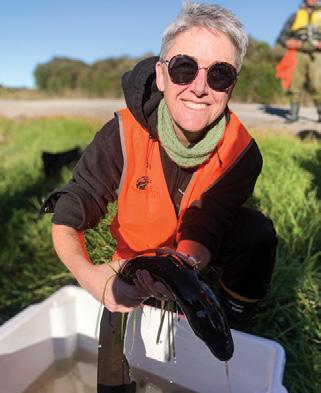
INTRODUCTION FROM CLARE
I had my own personal reasons for this change in direction so late in life and knew – career-wise – that it was risky.
I have a deep love for this country and desire to make a difference. Living next to a stateowned reserve that is being decimated by pest plants and animals, I knew that I had to be the change, as government departments and agencies certainly didn’t seem to be in control of the situation. I wanted to know all the things! For example, how to identify plants and animals, pest plants and animal control methods and so much more.
The training is only twelve weeks, and a four-day week of actual training. I thought it would be a start but was realistic about how much you could learn in such a small-time frame. Well, I was wrong! Let me tell you, this is one intensive training course! Don’t let me put you off though, the hard work was worth it!
We all came from very different stages in life, with diverse backgrounds and education. We all left there equipped and empowered. It was by far the best training I have ever had, and it is wonderful to see where my intake has ended up six months down the track! I understand that 90% are now working up and down the country in some way, shape or form for conservation.
I have also had the opportunity to talk with people who work within the conservation sector, many of them for decades. The feedback I’ve got is that this comprehensive training is just what New Zealand needed. It’s relevant in a world of policy often written by those without onthe-ground experience or knowledge. The cadets are passionate, knowledgeable, and thirsty to learn more.
I’ve had comments saying that it’s the best conservation training they’ve seen coming out of New Zealand. People who are getting close to retirement say that they now have hope that this is a new generation stepping up to replace them.
Graduates are impressing those they now work for & giving hope for the future of conservation in New Zealand. Former cadet Clare Power asks Cadet Training Manager Emma Richardson what exactly makes this programme so successful.
So, what exactly makes this training programme successful, and in what way is it unique? I asked Emma Richardson, marine scientist, educator and Cadet Training Manager and tutor for the freshwater part of the programme.
TRAINING FOR REAL-WORLD CONSERVATION CHALLENGES
“When it comes to training, I believe much of the success comes down to our tutors and educators. We chose them for their specialised knowledge and real-world experience, but also for their ability to engage well with the cadets.
Often at a university – and I’ll use marine biology as an example – you might get a marine biologist who is teaching about a world that they have never experienced. You can have a PhD in marine science, teaching marine science but don’t know how to dive or drive a boat.
We have selected our tutors not only because they’ve probably spent the last 10-20 years in the real-world environment within their field of expertise, but also because they are highly skilled educators. They understand what cadets need to know to make a difference in the real world.
We teach both in the classroom and in the field, and we teach in our own personal way. It is very interactive, with an expectation for cadets to glean as much information from tutors as they can by asking questions and engaging with our tutors.”
MORE THAN JUST A NUMBER
“The cadets are more than just a number to us. We care about them. We want them to make a difference in our conservation work. We want to prepare them to be our future leaders, to go on and teach their community, their iwi, to inspire others.
Often in formal education, they’re literally just a number. On the cadet program, we keep each intake small, no more than 11 cadets and we get to know them on a good
day and a bad day. We personally know their motivation for doing the course - what it means to each of them and their story, where they have come from.
We see them as a group on the first day, when they’re shy and not sure what they’ve got themselves into. Then we see them on the final day, when they’ve made lifelong friends and connections. They leave passionate about the environment, empowered knowing they can make a difference and ready to take on the conservation challenge. We follow their journey after they complete. They matter. For many of them this is a turning point in their lives and a beginning in a successful career in conservation. We now have trained almost 100 cadets, and a very high portion of them are working in meaningful roles in the conservation sector. That’s the impact of this unique programme.”
NO TYPICAL PROFILE
“There is no typical cadet. In any one intake you could have PhD graduates, factory workers with little formal education, seasonal workers, business owners or single parents and highly skilled individuals. They could be aged 18 or 60. And yet, it works.
At the interview stage we are looking for one thing and often within the first couple of minutes of an interview I can see it in an applicant. I know instinctively that they have what it takes to do and complete this programme. Their body language will demonstrate a passion for the environment and a desire to learn.
It is an intense crash course and not all days will be enjoyable. That passion and drive will get them through the tough days they may experience.”
FACILITATING LEARNING OPPORTUNITIES AROUND MĀORI TIKANGA, METHODS & HISTORY
“Wherever we can, we also include opportunities for cadets to meet and learn
20 WWW.BAYCONSERVATION.NZ P 07 808 0710 BCA TAUIRA MAHI CADET TRAINING
from Māori educators and visit iwi-led conservation projects.
One example of integrating traditional practices and modern technology is the research around the invasive Asian paddle crab in the Bay of Plenty. This is led by Manaaki Te Awanui and cadets get to meet and talk with researchers Jasmine Apaapa and Garston Smith and learn some of the background into their research methods.
Traditional practices have evolved from generations of Māori living and working with the land here in Aotearoa. The customary practice of gathering kai is the cornerstone for many and through this practice, the environment was observed, and methods of sustainability developed. This information was passed on down to the next generation over many hundreds of years. Each generation would gather more knowledge.
So, there is deep understanding of the whenua and its ways. We introduce the cadets to a very small part of this knowledge and really appreciate the support that
Aroha Ririnui and Des Heke-Kaiawha (Ngai Te Ahi and Ngati He) provide us. This is a conservation training course specifically for New Zealand, so if there’s an opportunity to learn from people who hold this knowledge it’s a no-brainer. Doing this is not only entirely appropriate, essential for understanding, but adds meaning and depth to the training, and for some, a sense of connection they lost somewhere along the way.
SOME OF THE MANY TUTORS & EDUCATORS
“Thomas Knight is a Wildlife Biologist and Cadet Programme Educator with a very keen interest in birds, and biology. He and I are the main programme facilitators. We’re the main contact for cadets if they are having any issues. We interview cadet applicants and liaise with conservation groups, to arrange on-site visits for field work.
When teaching we cover some of the monitoring or what DOC would call the ‘outcomes monitoring’ methods. So that’s things like how to determine the health of your stream or how to survey for bird numbers in the bush. Some of this is done in the classroom, but much of it is hands-on in the field.
Emma Cronin is BCA Operations Manager (Western BOP) and Director and Project Manager for her and her partners business Ethos Environmental. She draws on her decades of experience to teach about GPS and GIS mapping, and the importance of monitoring and data collection. She introduces cadets to pest animals and trapping devices both in the classroom and in the field.
Wayne O’Keefe is BCA Operations Manager (Eastern BOP), our resident plant guru and very involved with several other
NUTS & BOLTS: BAY CONSERVATION CADETS, TAUIRA MAHI PROGRAMME
Based in the Bay of Plenty
Started in 2021
12 weeks training
Three courses a year
13 intakes funded through Jobs for Nature Funding
Funding finishes in June 2025
Up to 11 cadets per intake
Open to 18-years and over
Cadets at Ōtanewainuku Trig
BAY CONSERVATION ALLIANCE
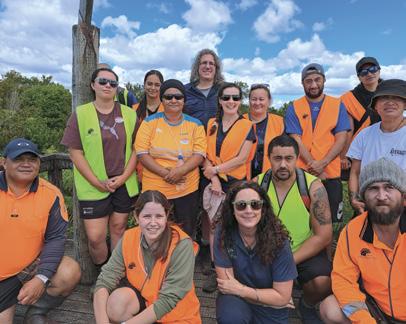
conservation initiatives initiatives around New Zealand, including Tane’s Tree Trust. He spends time with cadets both in the classroom and in the field, looking at native plants, regenerating forests, monitoring methods, and how to plant for long term success.
A cadet favourite is the week they spend with John Bissell from Backblocks Environmental Management Ltd. He comes in and blows everyone away with his knowledge around animal behaviour. He teaches them how to think like an animal, ways to become a successful predator hunter. He has an amazing way of telling a story, and he’s incredibly passionate.
We understand the importance of relevant training and certifications to aid employment, so we hand-pick the best providers to train and certify cadets for using an LUV, outdoor first aid, Growsafe, and more.
The programme is intense, and we expect a high level of commitment from every cadet. If they are struggling in an area, we are here to help. As intense as it is, we have only had a couple pull out over the years.
I am driven because I want the world to be a better place, for people to be more connected to their environment and become happier by doing a job that they love wholeheartedly. The environment is crying out to us for help, and we need to train people and develop their capability to do a better job for conservation.
What keeps me going is when I think about what we are achieving through this programme, and its mind-blowing. All the cadets that have come through are unique, yet they have had an experience that has been almost like an awakening, and they feel empowered. Many of those people will go on to do great things for this country and the environment.
If you could do that with every single person in New Zealand, or have a programme like this in every region, I firmly believe that we could heal the land. But to heal the land, we must feel connected - a part of the land. That’s what makes this training unique.”
Finals Words:
Cadet Graduate Comments
“BCA Cadet Training made it clear what path my life should take, I now can’t see myself working anywhere other than in conservation.”
MARK VEVERS
“I wasn’t involved in conservation at all before the course. Now I am the Education Coordinator for the Whakatane Kiwi Trust and also a volunteer on the kiwi monitoring team, and work one day a week at a forest school.”
HELEN INGLIS
“I’d applied for multiple conservationrelated jobs prior to the cadetship, with little success. Post cadetship I am now a biodiversity ranger, and I think the mix of skills and teachings we had as part of the cadetship was very valuable - not to mention the connections with other people I was able to build.”
DEVON ROBINSON
“I whakapapa from Pirirakau and haven’t really known anything about my whakapapa. I’ve slowly been learning who I am and where I am from. So the cadet programme has helped me to understand a lot.
MISTY PENI
“Be prepared for it to change your life, in the best way possible! I now feel a better sense of connection to the environment. The mix of theory sessions and practical outdoor experiences allowed me to bring it all together, [and understand] why the conservation field is so important!”
HANNAH THAIN

LOOKING BACK ON 2023 21
We ask Janie Stevenson, BCA’s Education & Engagement Manager
Words: Clare Power
Fostering Wonder & Empowering a New Generation
Nature Education Programme
When Bay Conservation Alliance (BCA) was set up in 2017, they sent a survey to the original four member groups to learn more about them and some of the common challenges they faced. The intention was to set up systems to support them in these areas.
One challenge was supplying conservation education into schools. Some groups already offered education to schools, with volunteers delivering the programmes, but due to the nature of volunteer support, funding challenges and limited available resources they often found it difficult to consistently deliver their programmes.
What was needed was funding for a dedicated paid educator and the creation of a targeted education programme using combined resources that was structured for long term use. This resulted in BCA running education programmes on behalf of two of the member groups: the Ōtanewainuku Kiwi Trust and Aongatete Forest Project with original funding from the Bay of Plenty Regional Council and Acorn Foundation. As demand grew Ballance Agri-Nutrients came on board as a corporate sponsor enabling more students to benefit.
In 2021 BCA received funding from Western Bay of Plenty District Council to
Nuts & Bolts
NATURE EDUCATION PROGRAMME
OUTLINE: Eight learning units, two-year rotation within each year group
STRUCTURE:
Each unit includes 1 x 1.5 hour in-school lesson and 1 x day field trip
TIMETABLE: One unit per term
TARGET:
Years 5 & 6 (9 to 11-year-olds)
Years 7 & 8 (11 to 13-year-olds)
CLASS SIZE: >60 students
AREA: Currently Western Bay of Plenty
FUNDING: WBOPRC
SCHOOLS: Whakamārama School, Ōmokoroa No.1 School, Ōmokoroa Point School, Te Puna School, Katikati College (year 7-8), Waihi Beach School, Pahoia School.

run a different programme targeting seven schools in the district. BCA set up a broader Nature Education Programme, aligned with the MOWS education programme and runs this alongside the programmes for Ōtanewainuku Kiwi Trust and Aongatete Forest Project.
THE OVERALL GOAL
The programme has been set up with great thought into how best to work with schools and students. The aim is to equip and empower the new generation to not only mentally care for the natural world around them, but also have knowledge of how they can make a difference, and desire to put that knowledge into action.
So, although each module has classroom time that sets the unit’s learning foundation, it’s the day in the field that brings it to life. Nature, when given the opportunity, works its magic within a child, and an adult!
FREE EXPLORE
BCA’s Education & Engagement Manager
Janie Stevenson explained that during field trips they include time for students to freely explore. This time can help cement some of the new learnings from the module, giving them the opportunity to explore, discover, question, and look for answers in their own time.
It may be the first time they have been in a particular environment, or - with their new-found knowledge - it may be the time they need to feel a connection to the land. New questions that arise during these times are often learning opportunities for many, including the adults. It is an opportunity to expand on what is taught in a module which are tweaked and improved each year.
SERVICE TO THE COMMUNITY
Most units include some type of volunteer work. Janie said that service to the
22 WWW.BAYCONSERVATION.NZ P 07 808 0710 WHAT IS BCA’S NATURE EDUCATION PROGRAMME?
community is an important element of our programme. Children are growing up in an environmentally challenged world which for them, may feel overwhelming at times. Taking part in community service fosters empowerment and helps them understand that they can be part of the solution and they can make a difference, starting today! This can lead to students, as well as schools, making a difference in their area. Some may go on to join or create local environmental groups or start conversations about caring about their community with friends, family, or iwi.
EMPOWERMENT TO ACT
The hope is also that students understand the power of their voice and use it when environmental decisions are being made. The other hope is that teachers, seeing how the programme is run, are inspired, and empowered with confidence to use the programme as a foundation to create their own modules, using local areas for field work.
One of the challenges for teachers of students in years seven and eight is being able to get release time for field trips. By recognising and incorporating learning opportunities from other curriculum areas in modules, learning outcomes are even better! Seeing the value of this will hopefully mean release time becomes less of an issue.
FEEDBACK:
Te Puna School: Students loved the water testing and bugs and overall found the trip really useful. Lots of good discussion in class afterwards. We loved that it was hands-on, and all the kids got to experience every aspect.
Pahoia School: All the students said that the trip was well worth doing and that they learnt a lot during the day. They said they felt that they’d contributed to helping the dunes survive.
Katikati College: The highlight for the students was the planting, because it was interactive and the trapping because it was interesting to learn about the animals, not just why we need to remove them.
THE UNITS:


Year One:
UNIT ONE: FRESHWATER
Students explore the plant and animal life within our unique freshwater stream and river systems. They find out about water quality and what we do to help protect our local stream health.
UNIT TWO: SOIL
Students learn about our precious soils and how we can help to keep them healthy. They discover what happens below ground and how it contributes to our food and life and develop an understanding of how soil can move across the landscape and how we can prevent sediment build up.
UNIT THREE: FOREST
Students experience the beauty of the forest at Aongatete and enjoy a tramp through lush NZ bush. They explore some of the conservation work being done to protect the Kaimai Mamaku Forest and the special species within it.
UNIT FOUR: MARINE
Students learn about the fish species found at our local beaches, harbours and estuaries, and find out how scientists count fish and monitor the health of their habitat. They practice identifying and surveying local fish species,
Ōmokoroa Point School: The students had a great day and were very engaged in the activities. Some of their highlights were the bush walk, using binoculars to look for birds, identifying the birds’ calls, learning about insects and exploring the bush around the Burma trail.
Te Ākau ki Pāpāmoa: We are going to look at Te Āra ō Wairakei by our Kura, and doing similar investigations to bring awareness to this area and see how we can help to keep restoring the mauri of this area and our role as kaitiaki.
UNIT FIVE: ESTUARY
Students learn that our estuaries are home to many species of kaimoana, plant life and birds. They discover what makes these areas so special and what is threatening our native species.
UNIT SIX: CLIMATE CHANGE
Students learn about climate change, how it may impact our way of life and what we can do to lessen the impact. They put their knowledge into action by planting native dune plants and weeding pest plants to restore our local sand dunes, the buffer between the land and the high seas.
UNIT SEVEN: WETLANDS
Students learn about wetland habitats, their special qualities and processes. They get muddy while helping to restore a local wetland with native plants and check for wetland bugs, birds and fish.
UNIT EIGHT: FOREST
Students experience the beauty of the forest at Oteora. Tramp through the forest and learn about the native birds, invertebrates and reptiles that live there. They learn about introduced pest species, and methods used to protect our forests from predator pests.
Year Two: Get Involved!
Are you an expert in something environmental or do you think you may have a resource or access to something that would spark interest with the students?
Janie would love to hear from you! Please get in touch for more information by emailing: education@bayconservation.nz
LOOKING BACK ON 2023 23 CONSERVATION ALLIANCE BAY
Myrtle Rust JOBS FOR RESISTANCE PROJECT


BCA Member Group, Rotoiti 15 shares their response to this threat & involvement in the fight to protect against the fungal disease
Myrtle rust arrived in New Zealand in 2017 and has been spreading quickly. It is a particularly damaging fungal disease that can attack more than 30 native species in New Zealand. pōhutukawa, as well as rātā, manuka, kanuka, ramarama together with feijoa and eucalyptus are all susceptible to myrtle rust. Death of mature ramarama trees has been recently observed in the East Cape and the disease is escalating in the Bay of Plenty. Myrtle rust is a wind-borne disease and is impossible to contain.
BCA Member group, Rotoiti 15 shares their response to this threat and involvement in the fight to protect against the fungal disease and how this fits into their vision of kia hihiri te ōhanga, te oranga me te pukumahi i runga i te ngākau ngātahi (Working together to protect and grow the well-being of our people, environment and culture).
RECONNECTING PEOPLE TO NATURE
MAIN PHOTO: Heidi Dungey explains the myrtle rust cutting protocol at Waipungapunga track, Lake Okataina
SMALL PHOTO: Otaki Grant and a visitor from the Australian Catalyst Exchange closely inspect a Ramarama branch
Find out more about Rotoiti 15 on page 37
Rotoiti 15 Trust is on a journey to reconnect people to nature and build a passion for conservation. “Our Trust is dedicated to combating myrtle rust by fostering a profound connection with our taiao (environment), both physically and spiritually. Our efforts extend to nurturing our whakapapa, forging strong ties to our whenua, and revitalising our traditional and innovative knowledge systems. In the face of the myrtle rust threat, our commitment to environmental harmony and cultural sustainability guides our actions, reinforcing the importance of safeguarding our native plants and ecosystems for future generations.”
Over the past two years Rotoiti 15 has partnered with Scion under the ‘Myrtle Rust – Jobs for Resistance’ project, funded by the Department of Conservation – Te Papa Atawhai as part of the Jobs for Nature programme. The project’s key objectives include developing and implementing a myrtle rust surveillance and monitoring program for the Bay of Plenty, assessing host susceptibility, conserving genetic variation for resistance breeding, and providing a transferrable template for regions susceptible to myrtle rust. The geographical focus initially encompasses Rotoiti and Rotomā, with plans to extend surveillance pending relevant approvals from mana whenua.
Over the course of the programme the Trust has been able to employ ten of our haukāinga (locals) to deliver on fieldwork throughout the project area. Working in the forest has been particularly rewarding for these kaimahi, (workers), — restoring lost connections with whakapapa and helping to unlock a sense of purpose for many employed in the Te Rātā Whakamaru programme. This aligns with the broader vision of not only protecting the environment, but contributing to the socioeconomic resilience of our people.
CONCLUSION
Through a holistic approach that encompasses ecological preservation, community well-being, and the revitalisation of traditional knowledge systems, Rotoiti 15 aspires not just to safeguard against myrtle rust, but to create a resilient and sustainable future for our taiao (environment).
24 WWW.BAYCONSERVATION.NZ P 07 808 0710
MYRTLE
15
FIGHT AGAINST
RUST Rotoiti
 Words: Clare Power
Words: Clare Power
When A Dog Plays With A Kiwi

To dogs, chasing kiwi is a game, but to kiwi it’s life & death
NO MATTER THE SIZE, YOUR DOG IS A THREAT!
Ground-dwelling birds are naturally intriguing to dogs – they don’t fly away! To dogs, chasing kiwi is a game. To kiwi, it’s life and death. Kiwi are different to other birds because they don’t have breastplates or chest muscles to protect their internal organs. Dogs, no matter their size, are the biggest threat to adult kiwi as it takes just a gentle nudge from a small dog ‘playing’ to potentially crush its delicate ribcage and internal organs.
So please ‘Auntie’, even though you say ‘Oh, don’t worry, he wouldn’t hurt a fly,’ understand that all dogs can kill kiwi.
SO WHAT CAN WE DO?
I caught up with Lydia Grunwell from the Whakatāne Kiwi Trust and she explained why Whakatāne is so unique.
Over 350 kiwi live wild in the surrounding hills nearby. There’s no other place in New Zealand where kiwi freely roam so close to a populated area. Kiwi can live up to 40 years if free from predation, but due to the constant threats, few kiwi reach this milestone. Dogs are the biggest threat to the Trust’s adult kiwi. Other threats include stoats and cats, and the Trust also works hard to control them.
It’s not just Whakatāne; dogs are killing kiwi throughout New Zealand and the public need to do their part to significantly lower risks that dogs pose.
YOU CAN MAKE A DIFFERENCE
When a dog kills a kiwi, it’s not the dog’s fault, it doesn’t know any better and is just being a dog. The responsibility sits solely with its owner. Unless a dog is trained, restrained or restricted, if it comes across a kiwi, it may think it’s a great game of chase, because weirdly this bird doesn’t fly away.
AVERSION TRAINING
Get your dog, no matter what the breed, aversion trained! If your dog is six-months or older and not on heat, then book them in to be aversion trained. It’s quick, harmless and effective, and significantly reduces the risk of your dog killing kiwi. Aversion training is available for weka as well.
Training involves using a correction collar to train dogs to stay away from the bird’s scent. If you have concerns or questions about the training, ask if you can attend a training day without your dog to see the process involved. Lydia said that research has shown when dogs were trained consistently, 87% of them still avoided kiwi scent after 12 months!
Some councils now even require landowners to have dogs’ aversion trained before they will sign-off on building consents, and more landowners are only providing access to hunters with kiwiaversion trained dogs.
MAKE SURE YOUR DOG ISN’T ROAMING
Make sure you know where your dog is at all times, or, when that is not practical, leave him in a secured area, with no way of escaping. Wandering pet dogs regularly kill kiwi. You may not think they would be interested, but trainers have noted that when the owner of a dog is not present, the animal’s interest in kiwi scent increases.
KNOW BEFORE YOU GO!
Find out where you can, (and can’t), take your dog. Unless a sign says otherwise, keep your dog restrained with a lead. If you are heading away on holiday to an area known to have kiwi, such as Whakatāne, make sure you can follow the local guidelines. If this is going to be impractical, then for your dog’s sake, leave them behind with a sitter or book them into kennels.
Certain areas prohibit dogs altogether,
while others only allow dogs if they have up-to-date aversion training. Make sure you know all the rules and restrictions before you head out. Search on council websites or join an online dog owners’ group to find out places you can take Fluffy.
REPORT WANDERING DOGS
If you see a dog wandering where it shouldn’t, please report it. You may just save a kiwi. If there’s an owner nearby and they seem approachable, have a polite word to them. They may not be aware that dogs are prohibited. Otherwise call your local council to report the dog sighting, taking note of the description of the dog and owner as best you can.
MORE INFO ABOUT AVERSION TRAINING: Nationally:
www.kiwiavoidancetraining.nz
If you live in the Whakatāne district: www.whakatanekiwi.org.nz for dates
WHO DO I REPORT ROAMING DOGS TO?
Report to your local city/district council. Details will be on their website.
WHERE CAN I TAKE MY DOG?
Find out on your local council website.
LEARN MORE ONLINE:
To find out how to act to protect both coastal wildlife & your dog, scan the code to watch the Department of Conservation’s programme Lead the Way.




LOOKING BACK ON 2023 25
BE SURE YOUR DOG IS NO THREAT!
Credit: Dreamstime Stock
Photo: @Lilun

FAR RIGHT: This titipounamu (rifleman), is one of the many native birds that call this place home.
QR CODE: Scan to go to our website and get more information about what we do, and how you can get involved!


In 2006 the Aongatete Forest Restoration Trust was established after a few visionary members of the Tauranga branch of Forest & Bird approached Katikati Rotary and Ngai Tamawhariua for help to set up a pest control and advocacy project.
Ground-based baiting and trapping primarily for rats, possums and mustelids has been ongoing ever since. It is a joy to see that many native species are showing encouraging signs of recovery.

Facebook: @aongatete
www.aongateteforest.org
Map Reference: Page 10
OUR EXPANDED KOHANGA!
In late 2022 we officially opened our expanded kohanga. Triple the size of our former building, this fantastic space can comfortably host up to 60 visitors — and all under cover! This is ideal for school groups that have been part of the BCA Nature Education Programme this year.
CHALLENGES - THE WEATHER!
What a wet year we had in the Bay of Plenty
last year! We had to postpone so many volunteer sessions and baiting operations. This was incredibly frustrating and impacted our volunteer turnout.
GET INVOLVED!
We warmly welcome new volunteers, casual visitors and corporate groups to Aongatete Forest. We run volunteer mornings on the first and third Wednesday of every month. There are a variety of pest control and line maintenance tasks on our ‘To Do’ list.
Throughout the year, specific Saturday mornings are earmarked for major baiting campaigns. Many hands are essential to help put bait out, or bring it back in.
Once you’re done there’s always a hot cuppa and usually some delicious home baking on offer at the kohanga. Please scan the code to find out more. Otherwise check out our website for events held throughout the year.
26 WWW.BAYCONSERVATION.NZ P 07 808 0710 NEWS FROM AONGATETE FOREST PROJECT
We are a volunteer group that manages 500 hectares of native forest in the Kaimai Mamaku Conservation Park, between Tauranga and Katikati.
ABOVE: Volunteers enjoying the social aspect of helping out. This group are inside the kohanga bagging Doubletap in preparation for a baiting operation.
RIGHT: In June AON spent some time volunteering for us as part of their corporate commitment to communities.

There is no classroom better than the outdoors! Through our camps, we promote a love and passion for the outdoors – recognising that the children of today are the guardians of tomorrow.
We focus on environmental education, outdoor safety, and sustainability, which provide valuable opportunities for learning. Our activities are designed to foster the development of positive life skills and offer memorable learning experiences within the Kaimai Forest Park.
Aongatete Outdoor Education Centre is a leading environmental education centre and is located on leased Department of Conservation (DOC) land. It is managed by the board of the Kaimai Outdoor Centre Inc.
Board members are volunteers, and a resident manager is employed to run and oversee the centre and is assisted
The more children are exposed to nature, the more likely they will fall in love with nature & become the future guardians of our land.
by six instructors, all passionate about environmental education. As a not-forprofit organisation, all profits and donations are directed towards the improvement of facilities, activities, and programmes.
OUR CHALLENGES AND GOALS
Many of the groups who visit AOEC now include the Environmental Education module in their camp programme. However, it takes constant effort and persuasion to get the module included into traditional school camp programmes.
When camp budgets are limited, we


notice that groups are more likely to exclude Environmental Education modules and include other activities. Yet those groups that do include any of our Forest Discovery and Environment Education modules in their programme, say that they were amazed by how much fun these interactive sessions were. So, they are pleased to have experienced them and say that they will not only include them in their future camps, but also in their class/ school curriculum.
Our goal is to seek funding so Environmental Education at AOEC can be free or can be subsidised, so that all groups visiting AOEC will be able to include at least two of the five modules we currently offer in their camp programme.
GET INVOLVED!
We would struggle to exist without volunteers. We always welcome individuals, families and interested groups.
We have several working bees each year and if you have children, you can bring them along! We will keep them busy with activities, so they learn about their natural environment, as well as offering rock climbing, archery and other activities. Head to our website to find out more.

ABOVE RIGHT: Students love getting to see our native birds up close when learning about them.
QR CODE: Scan to access more information about what we do, and how you can get involved! It will take you to our website

www.aoec.org.nz
P: 07 5783477
E: info@aoec.org.nz
16 Pikirangi Road, Aongatete (formerly 834 Wright Road)
Map Reference: Page 10
LOOKING BACK ON 2023 27 NEWS FROM AONGATETE OUTDOOR EDUCATION CENTRE (AOEC)
ABOVE LEFT: Students enjoying being outdoors during a Forest Discovery day.
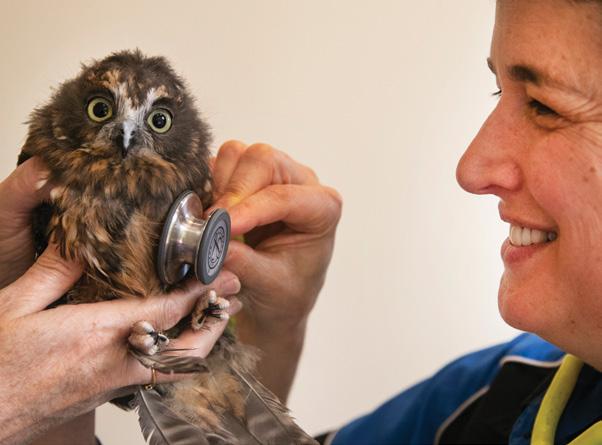
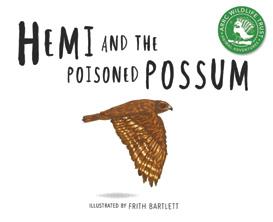



arrc.org.nz
56 Fraser Street, Tauranga P: (07) 579 9115
Facebook: @ARRCNZ
Map Reference: Page 10

Founded in 2003 by Dr. Liza Schneider, ARRC Wildlife Trust assist the Department of Conservation, vet clinics, and the public with the rescue and rehabilitation of injured and orphaned wildlife in the Bay of Plenty. In 2023 they celebrated their 20th anniversary!
Our goal is to provide specialised services, programmes, and facilities for the rescue and rehabilitation of wildlife and animals, and to demonstrate, educate, and inform our community about the importance of respect and responsibility for the well-being of our wildlife, animals, and natural heritage.
LAST YEAR
In 2023 we continued to take in, and care for more than 700 birds and wildlife.
We believe that collaborating with other organisations is an important priority. In 2023 we were excited to have set up an aviary together with Aongatete Outdoor Education Centre, which will be used in the rehabilitation and soft release of suitable species into the surrounding area.
We also worked with Bay Conservation Alliance, hosting Bay Conservation Cadets throughout the year. During their visits we educated them about the importance of wildlife rehabilitation.
Working with DotWatch in Waihi Beach, we created our newest children’s book Zigg and Zagg’s Dotterel Dance. This was recently launched and to buy a copy use the QR code to head to our website and shop online.
GET INVOLVED!
Native wildlife can only be looked after by people who have permission from the Department of Conservation (DOC). Nonnative wildlife such as thrushes, sparrows, and most ducks may be cared for by anyone, but it is important to have a working
knowledge of how to care for them. Find out what to do if you find an injured bird on our website. (Scan the QR Code.)
DONATE
You can also help by donating to the trust. We are a charity and not-for-profit trust, reliant on public funding and the kind support of local businesses. Without the support of our local community, we would not be able to continue the work we do.
SHOP WITH US
Check out the series of children’s books we sell on our website! Based on true stories from ARRC, they are delightfully educational.
An example is one Frankie and the Flypaper which tells the story of an adventurous and fun-loving fantail called Frankie. He is a native bird that enjoys a wonderful life in the forest, but one day he seeks adventure by flying into a cottage and becomes stuck in sticky flypaper. Two big men find Frankie and rush him to ARRC where he is given special care. Once recovered, he is taken back to his forest to be reunited with his fantail friend, Fiona.
TOP: A small selection from the series of children’s book based on our true stories!. These are available on our website.
ABOVE LEFT: This morepork looks happy to be in safe hands.
QR CODE: Scan to go to our website.

28 WWW.BAYCONSERVATION.NZ P 07 808 0710
NEWS FROM ARRC WILDLIFE TRUST


Matatā Conservation Care Group is a conservation group formed two years ago by residents of Kōkako Heights, (situated at the coastal end of the Manawahe Ecological Corridor), to work together in an area of native forest they share.
By protecting the area from plants and animals that threaten it, we hope to give native seedlings a chance to become saplings, and, for some, eventually be part of a canopy for the next generation.
We have a good, (bad), selection of the many undesirable plants and animals, including most of the usual suspects, but also struggle with massive plant predation by wallaby and native plant strangulation by climbing asparagus.
Our goal is to work to improve the health of the forest. This in turn will support increased numbers and variety of native bird species and other native plant and animal species, as well as increase the health of the streams that are part of the catchment that feed into Matata Estuary.
Longterm, we work towards being ready for North Island kōkako. Locally, Manawahe Eco Trust are working to create corridors to give these birds the area they need to survive as a local population.
OUR 2023 PEST FOCUS
The main goal in 2023 was to put in place strategies to get control of the possum numbers, so we could then tackle the rodents. In July, 66 leghold traps were installed and used over 5 nights on the western boundary. This significantly lowered our possum population, and next on the list was a rodent blitz.
Tom from Regen Services installed two monitoring lines within our project area this year and pre-bait monitoring showed levels for rats was 30%. With Bay of Plenty Regional Council’s support, we filled our 116 stations with pindone in spring. Six weeks later the levels sat at 0%. We then set up two possum trap lines on the western boundary to maintain possum control. These are cleared and rebaited weekly.
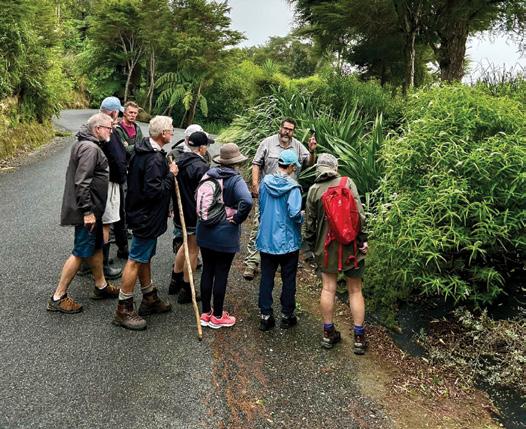
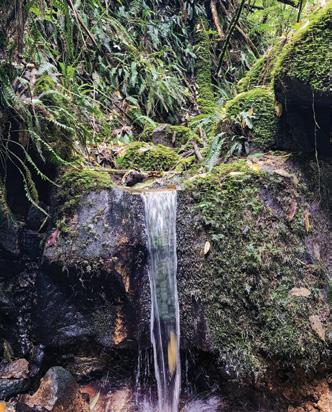
THANKS TO BCA AND OTHERS
Support from Bay Conservation Alliance (BCA) has been nothing but game changing. Their ongoing support and training helped equip us with the knowledge we need to plan a strategy for the next few years. Booths Logistics and the Steele family kindly donated AT220 traps. These are being used in a more difficult to access area and so far, we are impressed. Thanks also to Tom from Regen Services for the donation of a possum trap and the Richardson family for a Brownings Trail Camera. Both have been put to good use!
WHAT, WHERE AND WHEN
We held two onsite education days with BCA’s Wayne O’Keefe and Emma Cronin.
It is so easy to get overwhelmed when starting out. Wayne spent a morning in the bush helping us identify plants and we looked at our plant and forest health. Taking a step back and analysing what is there, before going in all gun’s blazing, has helped us put things into perspective and use our limited resources in the most effective way.
Emma’s trapping education day gave us a chance to see and handle the many different devices and find out which trap and bait options are better suited for each pest species.

Sometimes conservation work can feel overwhelming, and it is hard to know where to start. Taking time to step back, observe and then plan has helped us to prioritise.
TOP: Wayne O’Keefe from BCA visited our group and helped us identify plant species and recognise pest animal sign in the bush.
BOTTOM: Emma Cronin, BCA with Den Phillips, MCCG Chair having a break while marking possum trap placements on a boundary ridge.
Facebook:
@matataconservationcaregroup
Instagram: @mcecaregroup
Map Reference: Page 10

LOOKING BACK ON 2023 29
LEFT: A hidden waterfall within the bush.
NEWS FROM MATATĀ CONSERVATION CARE GROUP
Friends of Tarawera Trail

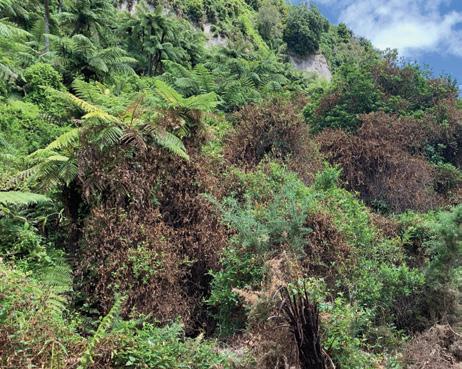
ABOVE:
Friends of Tarawera Trail are group of volunteers concerned about the effect of pest predators and invasive weeds on the native bush in and around the Tarawera Trail area.
Our goal is to give the forest the best chance of a sustainable future by setting it free of the damaging weeds and pest animals, allowing nature to restore the forest, and contributing to the country’s goal of being pest free by 2050.
The forest health is in a state of decline with its ecosystems damaged from dominating weeds, (mainly Japanese honeysuckle) and pest animals. The balance is at a tipping point, risking mauri and longterm biodiversity of this special area.
The project aims to be a community focus, with involvement and support from different stakeholders and volunteers from the community. The area is Department of Conservation (DOC) managed land, and we have support from Iwi, DOC, Forest and Bird Rotorua and the local charitable trust Tipu Wai.

Facebook:
@Pest-and-Weed-Free-Tarawera
Map Reference: Page 10
Our long-term vision is to have control of the honeysuckle in the whole area. This is a lofty goal and technically a difficult thing to achieve. Background work is ongoing to bring experts onboard, measure the current state and generate ideas for large scale control of the honeysuckle.
Our short to medium term goal is to achieve control of the honeysuckle in a small, designated block and then plant suitable natives and carry out weeding follow-ups. This block will show what is possible and how biodiversity increases once the honeysuckle has been controlled. Control of honeysuckle is achieved by hand using the cut-and-paste method and then spraying any ground regrowth.
FIRST YEAR WITH BOOTS ON THE GROUND!
Friends of Tarawera Trail fully kicked off in 2023, after signing a community agreement with DOC in 2022. We ran multiple working bees and ASB were here weeding for their volunteer day. On the first three kilometres of the trail 32 rat traps are now installed regularly checked.
We became a member group of Bay Conservation Alliance as well as a Community Group under Bay of Plenty Regional Council (BOPRC). Project support increased with the help of Rotorua Rotary Club, Tipu Wai and Whakarewarewa Pest

QR CODE:
YOUTUBE CHANNEL: GEOFF REID NZ
Toitū Te Whenua explores the abundance, natural character and many pressures and challenges that our natural environment and people in the Bay of Plenty & Lakes district face. Environmental advocate Geoff Reid talks with kaumatua and industry leaders about the urgent need for changes to safeguard living systems and human health.
Free. We rallied interested stakeholders for the long-term vision of large-scale control from BOP Regional Council, Forest and Bird, Rotorua Botanical Society, Scion and SPS Automation. Currently we’re researching the feasibility of using drones to spray the honeysuckle over native bush in trial areas.
To move forward with this project we need more resources, expert involvement, funding, iwi support, public support. Any financial contributions will support a range of needs across our project.
GET INVOLVED!
We welcome volunteers to our working bees, as well as more regular trap checkers. Being a newly formed project with only a small group of volunteers - one person volunteers as project lead - we appreciate support in any form. Get in touch through our Facebook page.
30 WWW.BAYCONSERVATION.NZ P 07 808 0710
NEWS FROM FRIENDS OF TARAWERA TRAIL
TOITŪ TE WHENUA
LEFT: Enjoying a well-earned break after some hard mahi in the bush.
Volunteers work to control honeysuckle in a small block so it is ready for planting suitable natives in the future.
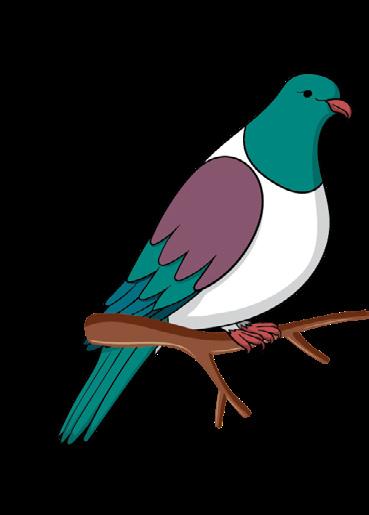
Friends of the Blade are an all-volunteer community care group operating under a community agreement with the Department of Conservation (DOC).

our 23 trap lines every fortnight. These traps, which specifically target possums, rats, mice, mustelids, and other introduced species, are DOC approved instant kill devices that adhere to National Animal Welfare Advisory Committee standards. It’s important to note that we exclusively use non-toxic lures in our efforts.

friendsoftheblade.org.nz
friendsoftheblade@gmail.com
Facebook: @friendsoftheblade
Map Reference: Page 10
The area we cover, once extensively logged in the first half of the 20th century, spans 300 hectares. Whenever possible, our volunteers work to expand this area by marking out and cutting new trap lines.
USING MODERN TECHNOLOGY TO WORK SMARTER, NOT HARDER
In 2023 we were able to secure funding from various sources to establish a “virtual fence” of AT220 auto-resetting traps around the perimeter of the area that we trap. They have exceeded our expectations in terms of stopping pest re-incursion from the surrounding forest. The auto traps are doing a fantastic job of catching most
Friends Of The Blade volunteers prepare to install new traps on their boundary

pests at the border without the need for constant checking and re-setting.
The impact of installing these devices means rat numbers have significantly lowered, and we have virtually eliminated possums from the 300ha area.
The 23 interior traplines are still regularly checked and re-baited by our volunteers, but now an internal trap line will often have less than two catches across 20-30 traps per fortnight.
GET INVOLVED!
We are very keen to welcome new members to the group of volunteers. Find out more by scanning the QR Code.
From there, you can check out our calendar to see upcoming events, contact us using the contact form, or look at our volunteer resources page. There you will find heaps of helpful tips and information.

LOOKING BACK ON 2023 31 NEWS FROM FRIENDS OF THE BLADE






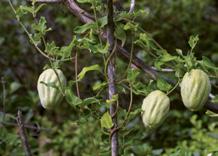
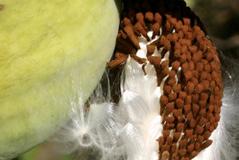
Scan the QR code to go to our website! www.halowhakatane.org.nz halowhakatane@gmail.com
Facebook: @HaloWhakatane
Instagram: @halowhakatane
Map Reference: Page 10
Our main vision is to create a habitat where Tīeke (Saddleback) can live and thrive in the heart of Whakatāne.
Halo is founded on the premise of Kotahitanga. We believe that when we unite our talents and resources, build relationships and connect people, we are empowered and enabled to achieve more together than apart. We are fortunate to be supported by an active group of volunteers and have a range of exciting conservation projects around Whakatāne.
HIGHLIGHTS FROM 2023
2023 was an incredible year for Halo Whakatāne, especially in the realm of our Education Programme. So far, we have successfully engaged with 3,867 students from eight local schools through various sessions. Our inaugural Local Schools Moth Plant Competition (DOMP Comp) was a huge success. Participating students played a crucial role in preventing the dispersal of over 12 million moth plant seeds in our local community! If you know about this pesky weed, you know how significant this achievement is.
We are also proud to have planted 6,000 native trees in 2023! We’ve already got 6,500 seedlings ready to plant in 2024. This has been part of our partnership with Trees for Survival NZ.
GET INVOLVED - IT’S AS EASY AS 1, 2, 3!
1. Want to set up a trap in your backyard? Head to our website and order a trap from us today!
2. What about volunteering for one of our local conservation groups? Meet like-minded people and learn more about conservation. Apply on our website!
3. How about taking part in a bird survey in your own backyard?
You can download a survey form on our website!
TOP: Tackling some invasive weeds at the Ōhope Spit with the Ōhope Spit Care Group & Halo Kaitiaki Kadets.
MIDDLE: (L) Signage from our planting day at the Kōpeopeo Īnanga Spawning Site. (R) Beach-front Halo trap at Ōhope.
BOTTOM: Moth plants produce masses of viable seed that travel long distances via wind. Our inaugural Local Schools Moth Plant Competition (DOMP Comp) was a huge success.
32 WWW.BAYCONSERVATION.NZ P 07 808 0710 NEWS FROM HALO WHAKATANE
Halo Whakatāne is a community led conservation project in the Eastern Bay of Plenty that aims to create a sanctuary in our local environment.
MOTH PLANT PHOTOS CREDIT: WEEDBUSTERS
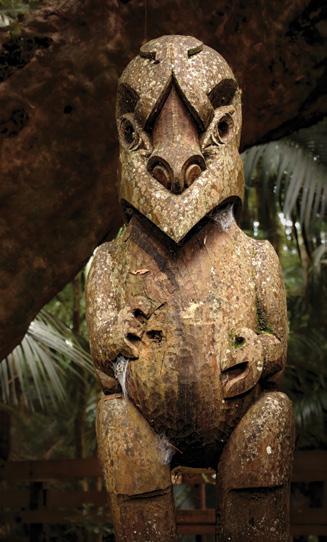
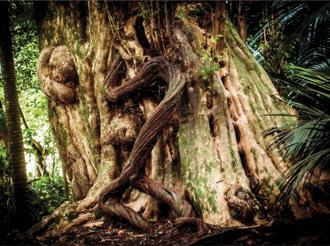

Hukutaia Domain was established over a century ago to safeguard Taketakerau, a magnificent puriri tree. It is estimated to be over 2000 years old and was used by Te Ūpokorehe to store the remains of their esteemed ancestors.
This 4.5-hectare remnant semi-coastal forest — primarily featuring tawa, kohekohe and puriri trees — has never been subjected to logging. It holds an extensive collection of native plants and trees, gathered over the last 90 years from all over New Zealand, by Norman Potts and Marc Heginbotham and others. The Hukutaia Domain Care Group serves as the current guardians (kaitiaki) of Hukutaia Domain in collaboration with Te Ūpokorehe.
We are a team of approximately 15 passionate volunteers who take great pride in preserving this local and national treasure. We receive valuable support from the Ōpōtiki District Council, the Bay of Plenty Regional Council, and various other local community groups.
Our mission is to protect and, whenever possible, enhance the natural and cultural values of the Domain. We are committed to expanding the botanical collection, improving visitor experience, and deepening their understanding of the Domain’s significance and inherent values.
NEWS FROM 2023
In 2023 Hukutaia Domain was a part of Te Whakatōhea treaty settlement and is now jointly owned by the Ōpōtiki District Council and Te Whakatōhea.
We entered our beautiful large old historical Puriri tree, Taketakerau, in 2023 Te Rākau o Te Tau, Tree of the year, Aotearoa. Although it didn’t win, it was a finalist!
Sadly, a kauri tree died at the entrance to the Domain, so the soil was tested for kauri dieback. Thankfully it wasn’t the cause, but we need to be aware of this disease and do what we can to protect our trees. Josh Scarrow from Bay of
Plenty Regional Council GPS’d kauri trees in the Domain and gave us good advice on helping to keep them safe.
We were delighted to have Bay Conservation Cadets visit and share the many treasures the Domain holds with them. We also appreciate Wayne O’Keefe, (BCA), for his time in beginning the process of creating a detailed plant list which will document the plants currently in Hukutaia Domain.
The Domain holds an extensive collection of native plants & trees, gathered over the last 90 years from all over New Zealand.
HOW YOU CAN HELP
To achieve our goals, we hold regular working bees and volunteers help with intensive pest control, monitoring, track maintenance, weeding, mowing, clearing rubbish, growing of plants from cuttings and seeds. To contact us and find out when our next working bee is happening, email pkaymcleod@icloud.com
Consider donating to the Norman Potts Memorial Fund to help us continue our work in the Domain. To find out more about this incredible place and how you can help, download our brochure by scanning the QR code below.
70 Bridge Street, Ōpōtiki
Map Reference: Page 10

LOOKING BACK ON 2023 33
NEWS FROM HUKUTAIA DOMAIN CARE GROUP
www.opotikinz.co.nz c/- Ōpōtiki i-SITE
www.opotikinz.co.nz
TOP: Hukutaia Domain holds deep significance with mana whenua, especially Ūpookorehe.
MIDDLE: Ancient puriri can support a wide range of life, including rātā vine, seen here growing up the trunk.
BOTTOM: Ancient burial tree, Taketakerau with a recently constructed boardwalk and steps to protect its roots and its tapu status.
PHOTOS: WAYNE O’KEEFE
VALLEY ROTARY CENTENNIAL TRUST
Kopurererua Valley Rotary Centennial Trust
The Kopurererua Valley Rotary Centennial Trust works with Tauranga City Council to help restore the Kopurererua Valley Reserve.
Kopurererua Valley is a 360-hectare block of low-lying rural land, extending from Judea in the north to Tauriko in the south. It is bordered by the neighbourhoods of Te Reti, Gate Pa, Greerton, Westridge, and Cambridge Heights. The project is believed to be one of the largest urban wetland restoration projects in Australasia.
The site is rich in history. For many years, Kopurererua Valley was inhabited by the people of Ngai Tamarawaho. Remains of pa and other archaeological sites are scattered throughout the valley. During the mid-1800s, it served as the staging point and retreat path for two significant battles between Māori and British Colonial forces – the Battle of Gate Pa and the Battle of Te Ranga. It is an area well worth protecting.
Four Tauranga Rotary Clubs are involved in managing bait lines and planting trees. In 2023 they planted over 2000 trees, and hope that eventually that valley will be the jewel in Tauranga’s crown.
An annual community cycling event, the Great K Valley Cycle Adventure, organised by Tauranga Sunrise Rotary, is a fun day out for the family, but also promotes awareness of Kopurererua Valley’s location, its history and the recreational opportunities it offers.
Since its inception in 2004, the Trust has raised $2.1 million towards wetland restoration
CONTACT ONE OF OUR CLUBS
TO FIND OUT HOW YOU CAN GET INVOLVED!
Tauranga Sunrise Rotary Club: www.rotarytaurangaam.club
Tauranga Te Papa Rotary Club: www.taurangatepaparotary.club
Tauranga Rotary Club: taurangarotary.org.nz
Otumoetai Rotary Club: rotaryotumoetai.club
Email:
michele@learningjourneys.co.nz Lyall Holmes at lyallh@xtra.co.nz
Map Reference: Page 10
2023 HAD A FEW HIGHLIGHTS FOR US
In February local Māori blessed the re-alignment of Kopurererua Stream. Seeing the first flows of water pouring into the recently constructed streambed was very moving. In September 2023 we had a very successful planting day with around 55 Rotarians and friends doing a substantial planting in the southern end of the Valley. This extended our kahikatea grove that was established in 2022.
With the support of Emma Cronin from
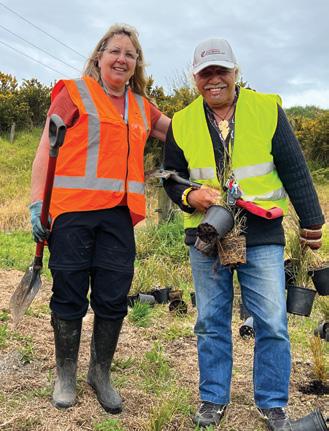
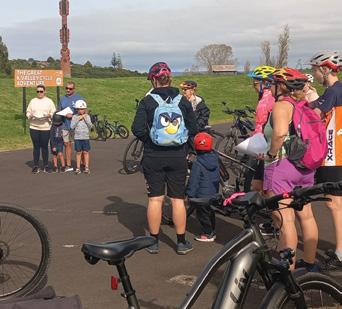
Bay Conservation Alliance, all four Rotary Clubs have actively taken part in predator control. This is incredibly important if we are to re-energise bird life in the valley. Emma’s expertise is greatly appreciated, and helped us have an effective trapping strategy, with health and safety a key part. We are now in the second stage of the re-alignment of the Kopurererua Stream. Once completed the re-development of the valley’s stream will make a huge contribution to the reduction of sedimentation reaching Tauranga Harbour. Increasing the stream length is expected to reduce flow velocities and increase sediment deposition on the submerged bench, (reducing sedimentation discharge to the estuary). Increasing sinuosity is also expected to enhance fish habitat within the stream. Works are well underway for the Southern re-alignment.
GREAT KOPURERERUA VALLEY CYCLE ADVENTURE
Date: 20 April 2024
Course: Short or long course options
Suitable for:
Families, work colleagues or groups of friends who enjoy ridingtheir bikes.
A fun event to help raise awareness of the biggest urban wetland reserve in New Zealand - Kopurererua Valley. Riders can experience all it has to offer. Learn about its historical and ecological value and its amazing ability to soak up the carbon dioxide that’s playing havoc with our climate.
Find out more:
@thegreatkvalleycycleadventure Fundraiser for the Graeme Dingle Foundation www.dinglefoundation.org.nz.
34 WWW.BAYCONSERVATION.NZ P 07 808 0710
TOP: Dianne Paton, Natural Environments Advisor, Tauranga City Council with Buddy Mikaere, historian,author and cultural consultant, Ngai Tamarawaho.
NEWS FROM KOPURERERUA
ABOVE: Competitors gather for the Great K Valley Cycle Race at the bottom of 17th Avenue.

Kaharoa Kōkako Trust work to protect the environment of the Kaharoa Conservation Area near Rotorua.
The Kaharoa Conservation Area is comprised of a number of distinct blocks: Aislabie, Ruato Stream, Kapukapu Rd., Onaia West, and Onaia East plus the Tapuika owned Te Pehu Pa Reserve. The total area under management is 952 hectares.
This area is a rugged piece of Crown land bounded by steep gorges and covered in native forest. It is home to a remnant population of kōkako. The Trust works closely with the Department of Conservation to protect these endangered birds.
The Trust was formed in 1997 by a group of locals. At the time, a research project in the northern portion of the forest (Aislabie block) recorded 26 kōkako. By reducing the number of pests (possums, ship rats, and stoats) across the whole area, kōkako numbers grew to 173 by 2015. However, the 2022 census showed a significant decline in numbers to 124. The Trust has focused on a number of measures to reverse this trend.
48 Kaharoa kōkako have been translocated to other areas to help found new populations or to add genetic diversity to existing ones. Translocations are managed on a national basis by the Kōkako Recovery Group (DOC). Kaharoa kōkako have contributed to populations in both the Manawahe Kōkako Trust and the Otanewainuku Kiwi Trust, our partner organisations in BCA.
We carry out annual pest control and have trialled many new toxins over our 25 years of existence. We routinely monitor the success of pest control operations through pre- and post-assessments of ship rat and possum indices. We recognise the importance of understanding the health of the Kaharoa ecosystem and, to this end, routinely monitor invertebrates, Pekapekatou-roa (long-tail bats), other forest birds, and some plants.


HIGHLIGHTS FROM 2023
2023 was an enormous year of work and achievements at Kaharoa. We upgraded our worst block for ship rat control - from 260 to 547 bait stations - to create a 100m x 50m grid and achieved our best ever results! RTI was 4% in that area.
By improving our trapping regimes we achieved a record year of kills of nearly every pest species! We successfully trialled Double Tap - a new toxin - and set up an ungulate exclosure to demonstrate browsing effects. We also set up an inforest equipment base.
We welcomed two new Trustees who made an immediate impact by resurrecting our Facebook profile and by completing a new website.
We did face some government redtape challenges though. Our pest control operation was a month late in starting due to a road block in the permitting process from DOC. And volunteers who were renewing their Controlled Substance Licences were denied 1080 inclusion by WorkSafe due to the incomprehensible ruling that they were not using it annually. This will seriously compromise how we carry out future pest control operations.
Due to a slip all access was cut off to the Aislabie block, but thankfully DOC had this repaired with a new road section in time for our pest control operation.
VOLUNTEER
People commonly think assistance is all about in-forest work via organised events or by adopting a track to carry out any necessary maintenance at any convenient time.
By improving our trapping regimes we achieved a record year of kills of nearly every pest species!
But there are many other ways to support us with skills, varying from accounts management, fundraising, specific species monitoring or research. We have jobs for everyone!
Information, both about upcoming events and our monthly work mornings, is posted on our new website and Facebook page. Active volunteers will also be sent an email.

LOOKING BACK ON 2023 35 NEWS FROM KAHAROA KŌKAKO TRUST
@ kaharoakokakotrust
Reference: Page 10
www.kokako.org.nz Facebook:
Map
LEFT: Some young detectives identifying foot prints. Getting the family involved with ship rat monitoring is a great way of inspiring a new generation.
RIGHT: Analysing the bite marks on Wax tags for outcome monitoring.

The Kōkako Ecosystem Expansion Programme (KEEP) was established in 2017 and collaborates with representatives from various conservation groups, community landcare groups, as well as mana whenua, private enterprise, the Department of Conservation (DOC), council, local landowners, Forest and Bird and QEII National Trust.

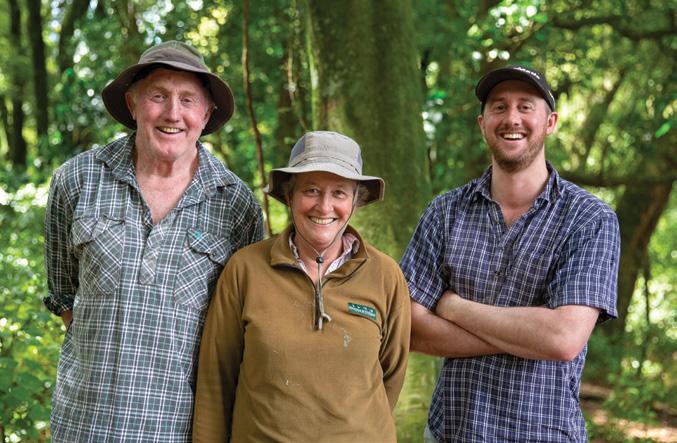
Our aim is to work towards increasing habitat and creating safe passageways for kōkako. The North Island kōkako was critically endangered in the 1990s, with only 330 pairs left. After a few decades of pest control to protect the nesting kōkako, the North Island population has grown to around 2000 pairs.
THAT’S GOOD NEWS – RIGHT?
Well, yes – but in order for a healthy population to exist in an area, it is believed there needs to be a minimum of 250 breeding pairs over 2000 hectares of forest. So, creating corridors between populations and increasing suitable habitat for their particular needs is essential to
Our aim is to work towards increasing habitat & creating safe passageways.
increase the gene pool and avoid the population stagnating.
COLLABORATION - THE CORE VALUE
The core value of the project is collaboration, and our first aim is to create a predator-controlled, vegetated corridor between Ōtanewainuku and Kaharoa. The Kōkako Recovery Group has identified a need for isolated populations of kōkako to expand (like the one at Kaharoa), and the creation of corridors has been suggested as an ideal way to encourage dispersal and interaction between populations of kōkako. Through this work, it will expand the genetic diversity of the kōkako populations and reduce the risk of potential genetic bottlenecks. Ultimately, it will create more connected and protected ecosystems within the Bay of Plenty landscape.
In addition to the benefits to kōkako, increased predator control in the area will have widespread biodiversity benefits and hopefully form a dispersal corridor for birds such as toutouwai/North Island robin and kiwi that are also present in the area.
ABOVE: The North Island kōkako. After a few decades of pest control to protect the nesting kōkako the North Island population has grown to around 2000 pairs.
HIGHLIGHTS FROM 2023
In 2023 KEEP received funding from Bay Trust, through the support of Bay Conservation Alliance supporting us as a fundholder and the allocation of project management support. This enabled us to become operational, better align ourselves to work with stakeholders and support the concept of green corridors linking kōkako populations.
We have also developed partnerships with Trees that Count, Tanes Tree Trust and The Reforestation Fund, which will see over 7000 native trees planted on private land over the next two years.
HELP MAKE A DIFFERENCE
Volunteer for your local kōkako conservation group, and become an advocate for green corridors. To contact us, or for further information and resources please visit our website using the code.
www.keep.org.nz

36 WWW.BAYCONSERVATION.NZ P 07 808 0710
NEWS FROM KEEP – KŌKAKO ECOSYSTEM EXPANSION PROGRAMME
Neil Robert Hutton
Stuart Attwood
LEFT: The Linton family farm in the Paraiti Catchment between Kaharoa and Ōtanewainuku, and have been actively fencing off and undertaking pest control in the forest remnants on their farm
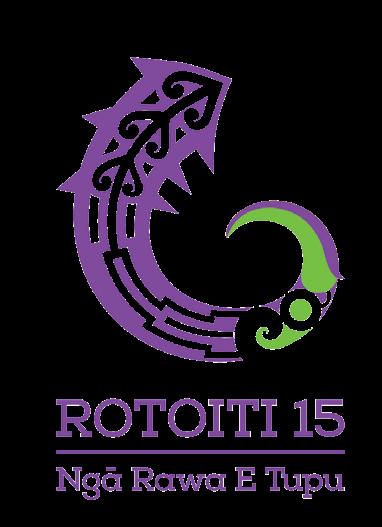


In order to honour the aspirations of our tūpuna, it is essential that everything the Trust does is focused on contributing to the aspirations of our owners, hapū and iwi.
Kia hihiri te ōhanga, te oranga me te pukumahi i runga i te ngākau ngātahi. - Working together to protect and grow the well-being of our people, environment and culture. Rotoiti 15 Trust is one of Aotearoa’s largest Ahu Whenua Trusts. Trust Mātārae (Trustees) care for over 8400ha on behalf of over 16,200 whānau who whakapapa to the whenua.
The whenua is currently in both plantation pine and indigenous ngahere (forest) and home to many historically important sites, including Makatiti, Haroharo and Haumingi and Okataina. Each block/maunga is rich in kōrero, whakapapa, history and sites of significance.
While the history of Rotoiti 15 Trust spans the past 60 years, the whenua (lands) have been occupied by our tupuna (ancestors) for generations. Our pūrakau (traditional stories) give insight into the undisturbed paradise that our tūpuna lived in, inhabited only by the children of Tāne, and the whispers of patupaiarehe.
A whenua rich in kākā, kererū, kokako, riddled with Tōtara and Rātā, the waters were stunning, the ngahere was so thick and dense, it was likened to a palisade. In contemporary times it is the Māori Land Court which captures the history of
our lands within the pakehā land tenure system, which began as an amalgamation of several land blocks derived from Ngāti Pikiao, Ngāti Rongomai and Ngāti Tarāwhai hapū lands, along with land received from an exchange with the Crown. This exchange demonstrates our forbearer’s commitment to environmental sustainability and maintaining land ownership for economic growth.
In order to honour the aspirations of our tūpuna, it is essential that everything the Trust does is focused on contributing to the aspirations of our owners, hapū and iwi.
Find out more about the threat of myrtle rust and what we are doing to work to protect our native flora on page 24.
Stay informed and be part of the movement and follow Rotoiti 15 Trust’s progress and initiatives by visiting our website and social media channels detailed on the right.

LOOKING BACK ON 2023 37 NEWS FROM ROTOITI 15 TRUST
www.rotoiti15.com Facebook: @R15Ahuwhenuatrust P: 07 343-7365 Map Reference: Page 10
TOP: View of Tapuaekura-a-Hatupatu marae, located on the southern shores of Lake Rotoiti.
LEFT: Taupe Paupoasa from Te Rata Whakamaru examines a Rohutu branch for myrtle rust.


MOWS is a community conservation group dedicated to conserving, protecting, and restoring the native biodiversity of the lower Kaituna River, Maketū Harbour, Waihi Harbour, and the surrounding area. In 2008, a small group of villagers came together to protect the colony of New Zealand dotterel (Tuturiwhatu) that breed on the tip of the Maketū Spit.
In the initial season, we could do little more than erect a simple fence and request people to stay out of the nesting area.
It soon became clear that safeguarding the dotterel alone was not enough. We needed to implement a broader plan to restore the ecological integrity of the spit, ensuring the security of not only the dotterel but also all other native animals and plants comprising the natural ecosystem. Since 2008, our group has expanded in both number and area
Currently, our focus is on conservation initiatives and ecological restoration on the following areas: Maketū Spit, Newdick’s Beach, Dotterel Point Pukehina, Waihi Harbour Wetland, Papahikahawai Island, Pukehina Esplanade Reserve and the Te Huauri o te Kawa wetland on the Kaituna River. We are currently negotiating the acquisition of an 8ha wetland in Waihi Harbour. Our work includes animal pest control, pest plant control, biodiversity monitoring and habitat restoration.
to encourage students to develop an understanding and become kaitiaki for their local environment through enjoyable and creative classroom activities and field trips. The programme also enables students to contribute to the community by participating in ecological restoration efforts.
HIGHLIGHTS FROM 2023
Te Huauri o te Kawa trail
We have been looking after this wetland on the bank of the Kaituna River since 2002 when our new Chair, Peter Ellery, started work to create a habitat for inanga (whitebait). As part of the improvements, we needed to upgrade two of the bridges and join them with a new trail through the centre of the wetland – this would improve access for weed and pest control and also open the site up for more educational visits.
Get in touch!
www.maketuwetlands.org.nz
Facebook:
@MaketuOngatoroWetlandSociety
Map Reference: Page 10
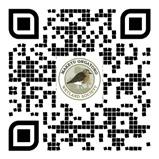
With our expertise in ecological restoration and a highly skilled and qualified team, we can offer our services externally. We provide a range of environmental conservation services delivered by our friendly and reliable staff. For more information about the services we offer, please scan the QR code. Feel free to contact us if you have any enquiries about how we might assist you.
We run a highly successful education programme in local schools in Te Puke, Maketū, Paengaroa, Pongakawa, and Pukehina. The aim of the programme is
However, the combination of a very wet spring and summer made the work extremely challenging especially as we had not appreciated that the middle section of the trail is flooded on spring high tides. The end result is impressive, the bridges are wheelchair friendly and we are now able to get to some of the pest plants that have invaded the wetland over the years.
Pukehina Esplanade Reserve
This is the stopbank that runs around the eastern end of Waihi Harbour. We have been working on this since 2019, clearing the trail and dealing with the pampas, gorse, wattles, boneseed as well as several small eucalypts and pines. This year we obtained additional funding and were able
38 WWW.BAYCONSERVATION.NZ P 07 808 0710
NEWS FROM MOWS - MAKETU ONGATORO WETLAND SOCIETY
ABOVE: The MOWS team celebrating another awesome year and toasting long-standing members, Julian Fitter and Maureen Binns, as they retire from their roles.


to employ a trained arborist for some of the larger trees, boy what a difference that made and while we have not quite finished, the reserve has improved immeasurably with a lot of new natives, including tree ferns, appearing now that they have more space and light.
Pukehina Wetland
While working on the Esplanade Reserve, we got to know the owners of the harbourside wetland immediately to the west of it. Last year they offered MOWS the opportunity to acquire the wetland at a nil cost. The one drawback was that we would have to pay the legal fees. As the property was classified as ‘Agricultural’ and was less than 40ha. we would need resource consent for the division of the property. That, along with the cost of surveying the site, is likely to cost us in the region of $30,000. Fortunately, we have managed to obtain the necessary funding and we are confident that the transaction will be approved. This would be a huge achievement for such a small Society.
GET INVOLVED!
Volunteer
We run regular working bees where we carry out tasks such as planting, weeding and removing beach litter. As our work covers the beautiful beaches around Maketū, you can be sure of a fantastic view while you work, as well as some great company! We usually finish off with a sausage sizzle to reward all your efforts!
Become a MOWS member:
We rely completely on the support of our members and volunteers to enable us to continue in our mission to restore and protect our local biodiversity. Without them our organisation would not function, so we are extremely grateful for the fantastic work they do. MOWS Memberships start at $15 per year for a student to $40 for a family. Life and corporate memberships are also available.
Donate:
Running an organisation is an expensive business. While we receive much of our funding from Councils and local philanthropic organisation which cover our main restoration projects, this does not cover all our core operating expenses and incidental costs for which we rely on doing external contracts and the generosity of our supporters who share our passion for what we do.
The importance of our work in preserving the native biodiversity cannot be overstated, and community conservation groups such as ours play a vital role in protecting species from extinction. Donations to help with the day-to-day operation of MOWS are always very much appreciated, and if your donation is over $500 you can specify on which project, piece of equipment, or general area you would like it to be spent.
For more information about getting involved, and working bee dates head to our website.
It became clear that safeguarding the dotterel alone was not enough. We needed to implement a broader plan to restore the area’s ecological integrity.
READ MORE:
Turn to page 11 were we interview, Julian Fitter, who recently stepped down from his position of Chair at MOWS. He was one of their founding members, first Chair and has also served as the Operations Manager. He has had an interesting past and has an insightful perspective on life!
LOOKING BACK ON 2023 39
LEFT: Getting ready for the first dune planting of the season to the Kaituna Cut. Find out how you can take part on our website. RIGHT: The sun was out as MOWS education team delivered their estuary unit in Maketu and Little Waihi with Te Ranga school.


The Manawahe Eco Trust (MET) was formed in 2010 to facilitate the community’s interest in improving biodiversity within the Manawahe Ecological Corridor — the only forested ecological corridor that exists between the Rotorua lakes and the sea.
Over the past 12 months, MET has merged with the Manawahe Kōkako Trust, a volunteer-run group with a 25year history of protecting and enhancing the Manawahe kōkako population. This newly-merged group manages a predator control programme that has over 1,000 bait stations and 660 traps, with the help of 50 regular volunteers.
The trust also runs a far-reaching schools
The Manawahe (approx. 4000ha) is clearly identifiable by conspicuous geographical features - rugged hills that rise suddenly from the Rangitaiki Plains.
The project area managed by the Trust is made up of many beautiful remnants of native bush spread across several different landowners’ properties, most of which are protected by QEII covenants. One of the long-term goals of the Trust is to work with
The Manawahe is clearly identifiable by conspicuous geographical featuresrugged hills that rise suddenly from the Rangitaiki Plains.
education programme. Since 2015 we have engaged with nearly 10,000 students, parents and teachers, and through advocacy within the wider community.
MET manages the Manawahe Ecological Community Centre, using it as a base for its education programme, as well as making it available to the community as a meeting place.
LOCATION
AND AREA COVERED
The Manawahe Ecological Corridor, named because this remnant natural habitat between Lake Rotoma and the Bay of Plenty coast, forms a continuation of the diverse ecosystem types that can be found across this 300m altitudinal range.

landowners to create a forest corridor to connect the Manawahe kōkako population with the larger kōkako population in Rotoma.
WHEN TWO BECOME ONE
It has been such an amazing year of strengthening our relationship with the Manawahe Kōkako Trust, and we have now successfully merged to form one group.
After much deliberation, we decided to keep Manawahe Eco Trust as our name, but we have a new vision that reflects the significance of the kōkako: ‘To enhance the mauri of Manawahe, for our mokopuna to hear the song of the kōkako from lakes to sea.’ We also have a beautiful new logo! We had incredible support from Janie from Bay Conservation (BCA) to lead us on this journey in creating our new vision.
manawaheecotrust@gmail.com
manawaheecotrust.org.nz
Facebook: @Manawahe
Map Reference: Page 10
FUNDING BOOST
We received a boost in funding from the Lotteries Community Fund to help grow our education programme, with a focus on schools closest to the Manawahe Ecological Corridor. Rotoma School was on board for this during 2023.
We got funding from Trust Horizon and Simplicity to buy 30 new AT220 autotraps, as well as two new cellular trail cameras, which will help reduce our carbon footprint. We are also fortunate to receive regular funding from Bay Trust, Lion Foundation and Aotearoa Gaming Trust
OTHER HIGHLIGHTS FROM 2023
In October, we held a fantastic high school adventure race on a local Manawahe farm, with schools from across the Bay of Plenty traveling to take part.
We were also given funding from the NZMCA to continue planting native trees next to our Education Centre. We had a couple of great community planting days. With the help from NZMCA volunteers and the incredible BCA cadets, we put in more than 1000 trees!
GET INVOLVED
We love our volunteers but we’re always looking for more people to help! From individuals checking one of our many trap lines throughout the year, to group working bees, we always have work that needs to be done. Scan the code to find out more about volunteering, or get information on the education programme. Why not hire our awesome Manawahe Ecological Community Centre for your next event or conference?
ABOVE: Volunteers enjoying a hard-earned cuppa after helping to fill 850 bait stations in Spring. Keeping rodent numbers at 0% for their breeding season makes a massive difference to the Manawahe kōkako!
40 WWW.BAYCONSERVATION.NZ P 07 808 0710
NEWS FROM MANAWAHE ECO TRUST


PiPS was formed in 2016 by a group of school parents in the Pāpāmoa Beach/Mt Maunganui area of Aotearoa New Zealand.
We are passionate about demonstrating to our tamariki and their whanau the principles of kaitiakitanga: respect and care for the environment, and an understanding of how to grow our own kai. Within the school environment a kai garden is one of the most effective ways we can ‘live’ these values. However, sustaining a school garden places a heavy workload on management, teachers and parent volunteers. These maara require ongoing planning, preparing, planting, harvesting, cooking and eating. The initial enthusiasm for a kura maara may wane, key volunteers may move on, or problems may arise that the kura has neither the time nor resources to tackle.
PiPS is an inter-school collective that employs part-time garden facilitators to work across our member schools, overseeing our maara and environmental programmes as well as other associated projects within the kura and our wider community. This makes it easier for a kura maara to become a permanent and contributing part of our schools’ environments.
We work with the Mauao Trust to gather seed from the Maunga,take them back to the kura where we sow and tend to them and then replant them back on the Maunga. We also work with Tauranga Moana Biosecurity Capital to deliver their Sentinel Garden programme.
HIGHLIGHTS/CHALLENGES FROM 2023
2023 was a growing year for PIPS. Our team of facilitators grew from just
two to four. Te Manawa o Papamoa started with the programme, where the community put in 16 garden beds and 46 fruit trees. Three of our participating kura have the whole kura taking part in the programme and for others the numbers keep growing.
We won the Western Bay Community Sustainable Future Award in March 2023, of which we feel very proud.
As a charity, we found securing enough funding for the 2024 year has been challenging.
We realise that we are a small team and need to remember to consider that and not take on more than we can realistically deal with.
GET INVOLVED!
Please contact us through the website of send us an email if you would like to know more about PiPs and how you can help.
FINAL WORDS
Remember to plant what you and your family will actually eat!

www.pipsbop.org
Instagram: @PocketofPIPS
E: pipstauranga@gmail.com
Facebook: Scan the code below
Map Reference: Page 10.


LOOKING BACK ON 2023 41 NEWS FROM PIPS
Mokaihaha Kōkako Trust
The reserve is the largest remaining remnant of native forest on the southern end of the Mamaku Plateau.


The Mokaihaha Ecological Area comprises of 2,127ha of native forest situated on the southern end of the Mamaku Plateau.
The Trust work with local organisations and businesses, iwi, local government and the community. Pest control is undertaken annually, and volunteers are always welcome to help with clearing bait lines and monitoring.
The reserve is the largest remaining remnant of native forest on the southern end of the Mamaku Plateau. Mokaihaha holds a significant population of genetically important North Island kōkako. A census undertaken in May 2022 recorded 71 pairs and 10 territorial singles an increase from 43 pairs and 8 singles recorded in 2018. North Island kākā, both species of bats, kererū, kārearea (falcon), kākāriki (yellow-crowned parakeet) and pōpokotea (whitehead) have been recorded in the reserve along with the more common native bush birds.
BIG STEP TOWARDS COMPLETING THE GROUND BAIT NETWORK
In 2023 contractors installed a bait station network covering the area that was not under ground control. We still need to finish cutting the track and marking this new network, but once this is complete, we will be able to undertake ground control on the full 2,127ha area.
Another highlight of 2023 was having the opportunity to host a number of educational and environmental events in Mokaihaha.
GET INVOLVED!
If people are interested in volunteering in Mokaihaha, please email mokaihaha@gmail. com and we will put you on our volunteer list. A couple of times a year we undertake rat monitoring and maintenance on our tracks. We use this list to email out to our volunteers the dates and details to see who is available to help.
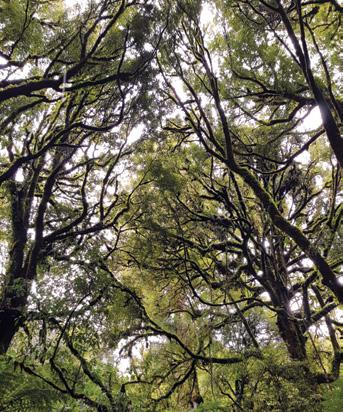
Mokaihaha
Trust Partners. We were able to witness and hear two kokako in the trees.
TOP: Kōkako feeding juvenile chicks on their nest.
BOTTOM: This canopy density is typical of mature tawa.

mokaihaha@gmail.com
Facebook: @Mokaihaha
Map Reference: Page 10
42 WWW.BAYCONSERVATION.NZ P 07 808 0710
NEWS FROM MOKAIHAHA KŌKAKO TRUST
The Mokaihaha Kokako Trust is working to ensure that Mokaihaha’s ecosystem thrives, and community wellbeing is strengthened.
LEFT: Dave Bryden explaining the kōkako survey results to
Kokako

The Motu Trails Charitable Trust is the governance and operational hub of the Motu Trails. Trustees are a group of community-minded people, most of whom are regular cyclists.
The Trust team promotes and manages the trails, with the goal that for both visitors and locals alike, the Motu Trails serve as a gateway to positive experiences for people of all ages and abilities. Ultimately, these efforts benefit the communities around the trails, stretching from Gisborne to Ōpōtiki.
With Ōpōtiki’s Dunes Trail, there is a strong conservation component. We have a biodiversity management agreement with Bay of Plenty Regional Council (BOPRC).
Over the last six years we have planted over 30,000 trees and other plants along the Dunes Trail. We hold three volunteer planting days most winters. Some planting days have seen over 30 people turn up! The level of regeneration along the Dunes Trail is remarkable and that’s thanks to the impressive community support we receive.
Additionally, with the help of Whakatohea Tiaki Taiao and other volunteers, and with traps provided by The Department of Conservation (DOC) community conservation funding, we have been implementing predator trap lines on Pakihi Track and the Dunes Trail. Hundreds of rats and about 50 stoats and weasels have been caught to date.
GOOD PROGRESS IN 2023
In 2023 we held three community planting days. When we combine what was planted

COMMUNITY TRUST

at those events with other plantings during the year, there are now 1700 more trees and plants along the Dunes Trail. We continued our trapping efforts and the results included over 30 stoats and weasels!
HOW YOU CAN HELP US
Volunteer time:
Why not come to one of the community planting days during winter? They should be held in May and June. Just email jim@ motutrails.co.nz around mid-April to get the dates or follow our Facebook page.
Make a donation:
If you would like to support Motu Trails Charitable Trust, please visit givealittle.co.nz/org/motutrails or donate straight into this account: Motu Trails Charitable Trust, 06-0637-0259896-00.
TOP: Planting day on the Dunes Trail, in winter 2023.
ABOVE: Many of the volunteers have joined 15 or more planting days over the years.
Facebook: @motutrailscycleway
Instagram: @motutrailscycleway info@motutrails.co.nz www.motutrails.co.nz
Map Reference: Page 10

LOOKING BACK ON 2023 43
NEWS FROM MOTU TRAILS COMMUNITY TRUST


Ōtanewainuku Kiwi Trust is a community-based conservation trust formed in 2002 by Te Puke Forest and Bird, along with other community members concerned about the decline of North Island brown kiwi in the Ōtanewainuku Forest.
We work to protect kiwi, along with other native animals and plants within the forest, through integrated pest management control. We have successfully reintroduced kōkako and kiwi into Ōtanewainuku Forest and actively advocate for the conservation of kiwi and the forest by engaging with schools and the wider community.
While our primary focus is on kiwi and kōkako, other animals including bats, lizards and invertebrates benefit as well. The trees, shrubs and other plants are thriving because fruits and seeds can complete their vital life cycles.
GREAT RESULTS IN 2023
In 2023 it was amazing to get a 0% for rats on our post-toxin monitoring. We used one round of Pindone with 500g in 2023.
We believe these results were due to a few factors. Prior to using Pindone we had placed sentinel possum traps at a ratio of 1 per 4.5ha and serviced them at least once a month. This was effective in controlling the number of possums entering from neighbouring properties, resulting in low possum numbers within Ōtanewainuku Forest. When numbers are low, there is little to no possum interference with the

www.kiwitrust.org
Facebook: @otanewainuku
Instagram: @otanewainukukiwitrust
Map Reference: Page 10
Pindone, so another benefit is that less bait is needed.
We also altered the design of the bait station floor by attaching rope, long enough to reach the ground below. This made rat access into the bait stations easier, resulting in a higher number of rats eating the toxin.
Throughout the year we saw and heard lots of kōkako, so we are looking forward to our 2024 census results.
And a highlight was Rohi, a two-year old kiwi, who surprised us with his first incubation of two eggs. We are pleased to announce both have now hatched.
Three years ago we lost contact with Cosmos, a six-year-old male kiwi, after his transmitter had dropped off. We are delighted to report we found him in 2023. He is now back wearing his new transmitter.
HOW YOU CAN HELP US
We welcome new volunteers. Come to one our forest workdays held on the second Sunday of each month. Simply register your interest on our website and we will send you full details. (QR code above.)
Strong support, from our sponsors and donors, means we can carry on this vital conservation work for the community.
44 WWW.BAYCONSERVATION.NZ P 07 808 0710 NEWS FROM ŌTANEWAINUKU KIWI TRUST
TOP: Volunteers meeting at the Ōtanewainuku carpark for a volunteer Sunday workday.
ABOVE: Receivers and transmitters are used to help us locate kiwi.


Established in 2015, our charitable trust is committed to the protection and restoration of the natural ecosystems within the sanctuary. Focusing on the conservation of the Otawa Hochstetters frog species (Leiopelma Hochstetteri Otawa), a precious native inhabitant of New Zealand, we work to ensure the longterm survival of this ancient and critically endangered species.
Through collaborative efforts, we are steadily transforming the land into a thriving sanctuary, nurturing the growth of native flora and fauna while actively involving the community in our mission.
Leiopelma frog varieties are found only in New Zealand. Of the seven different Leiopelma species recorded in New Zealand, three are already extinct. The Otawa Hochstetter’s frog is genetically distinct from the others and its only known habitat is in this former quarry site.
HIGHLIGHTS FROM 2023
In 2023 sentinel traps were installed and regular servicing of them was established. This expansion into possum control should see a reduction in their population, resulting in benefits to bird numbers and the vegetation. We have on-boarded several new volunteers this year, adding to our regular group of people. Four possum lines are now being serviced by our volunteers, and we have a new pest line using DOC200’s and victors, expanding our overall control area.
In the sanctuary we now have: 131 x DOC200 traps, 145 x Victor traps, 220 x Sentinel traps and 783 x A24s. There are also 20 DOC200s in adjacent farmland. We now have between 18-20 people involved in trapping.
A severe flooding event in January 2023 left the Otawa Sanctuary with extensive slips and damage to the key Hochstetter
frog habitat. DOC’s next frog survey will provide updates on numbers. Irreparable damage was caused to the culverts under the primary vehicle access within the sanctuary which has left it closed from the main entrance meaning there is no way for heavier vehicles or machinery to access the area.
Trappers Shed
We created a trapping hub by re-purposing a secondhand container, added a rainwater collection tank, long drop and solar powered freezer. This is now a comfortable and central base for our tools and gear as well as a place where we can record our data. Plans available on request.
GET INVOLVED!
Volunteer
Te Whakakaha Trust works in conjunction with the Department of Conservation (DOC) and an active volunteer network. Our dedicated volunteers play a vital role in various activities, including pest control, tree planting, fundraising initiatives and educational programmes.
We have plenty of work to do and we welcome anyone wanting to help out! By volunteering you become an integral part of our mission to safeguard our natural heritage for future generations. This will ensure that the Otawa Sanctuary remains a sanctuary of life, learning, and conservation.
Register your interest and check out the calendar on our website, to see our upcoming opportunities.
Finally, while visitors are welcome to explore the sanctuary, please don’t actively look for frogs. The frogs, and their habitats, are extremely sensitive to disturbance.

TOP: Adult female Otawa Hochstetter’s frog photographed under water, in secondary frog stream one month after the Auckland Anniversary storm.
BOTTOM: Our new container which has been set up as a trappers and service hub..
tewhakakahatrust.org.nz
tewhakakahatrust@gmail.com
Facebook: @tewhakakaha
1254 No 3 Road, Te Puke, 3183
Map Reference: Page 10

LOOKING BACK ON 2023 45
NEWS FROM TE WHAKAKAHA TRUST
Te Whakakaha Trust serve as the caretakers of the Otawa Sanctuary— a 400-hectare forest at the end of No 3 Road in Te Puke.
Credit: J Heaphy, Department of Conservation

PROJECT PARORE
The project spans eight catchments of the northern Tauranga Moana, from Aongatete to Waiau. From the bush-clad slopes, through the productive lowlands down to the harbour margins.

Project Parore
sustainable land management practice, water quality improvement and the restoration of native ecosystems on both public and private land.

Restoration project on private land

Restoration project on public land

Science & monitoring site

Special spotFlora, fauna or ecological feature

The roots of the project formed in 2004, when a group of local residents banded together to see if they could increase the number of native birds in the Uretara estuary by doing ‘a bit of pest control’.
Our project area now stretches from the northern side of Aongatete River to the salt marshes of Athenree, from the bush line to the harbour edge. Spanning eight catchments, we’re focused on approximately 16,000 hectares of land that doesn’t already have protection via DOC, QEII, Regional or District Council covenants.

projectparore.nz
07 808 3082
hello@projectparore.nz
Facebook: @projectparore
Map Reference: Page 10
Our aim is to stop soil, nutrients and pollutants from entering waterways. We do this by encouraging good management practices across all land uses, and helping to retire steep, marginal and riparian land into native vegetation and regenerating wetlands. We also have ongoing weed and pest animal control work that protect habitat and the wildlife that depend on it.
None of the effort necessary to protect and restore our waterways and whenua can be done in isolation. We work alongside individuals, landowners, hapū & iwi, councils, businesses, community groups, schools and funders.
GET INVOLVED?
Why not volunteer with Renaturing Katikati? We have weekly, monthly and seasonal restoration and protection work in and around our shared urban spaces. Get yourself on farm with some of the larger scale annual planting projects that happen on private land. Hills to harbour citizen science activities involve everything from vegetation surveys and bird counts to water quality monitoring.
Or you could start work in your local area by getting a group of neighbours together. We can support your efforts to protect a valuable area of biodiversity with our pest control knowhow.
Are you a landowner and is your land your livelihood? Are you keen to embrace practices that minimise and mitigate the impact of your activities on water quality? Let us help you put plans in place that meet your obligations and improve environmental outcomes for a sustainable AND productive future. We’ve got success stories we can share with you.
Contact us or find out more by scanning the QR code.
46 WWW.BAYCONSERVATION.NZ P 07 808 0710
NEWS FROM PROJECT PARORE
champions

Based in the hills between Pāpāmoa and Welcome Bay, we focus on restoration in the Waitao catchment.
The catchment is large and has significant native habitats. Extensive semi-coastal forest covers the upper reaches, while a number of smaller, yet surprisingly diverse forest patches, wetlands, and estuarine habitats are also present. This provides habitat for a wide range of native flora & fauna, some of which are locally rare and highly threatened.
Since 2001, we have collected native seeds, propagated them in our nurseries and in partnership with our local landowners planted them to restore native habitat, primarily in riparian zones and marginal farmland areas. Combined, members have an extensive native plant knowledge base and experience, and we are always keen to share this with others.
We hold regular community plantings and also have initiated a predator control project. The goal is to work together as a community to improve the health of these precious habitats, the Kaiate, Arateka & Waitao streams, and the Tauranga harbour through our activities.
HIGHLIGHTS FROM 2023
A few highlights from 2023 include catching our first stoats, seeing kohekohe fruiting profusely in the forests here (clearly enjoying significant reductions in possum numbers!) and observing some of our previous year’s plantings beginning to show their full splendour.
Our members are still spritely - which is well worth celebrating - butas the group is now 23-years old now, aging is a reality! We’re recognising the need to put more effort into attracting new members and partnerships.

And with this, we recognise the need to put more effort into attracting new members and partnerships to continue the legacy of what has been created here.
Significant gains in restoration of the catchment’s natural values have been made, but there is still much to do. So, we certainly hope that support can be fostered and this important mahi can continue here well into the future…
GET INVOLVED!
Volunteer - Attending one of our regular community potting days is a great way to get involved and support the restoration work that’s happening here, as are our community planting days, which always end with a great feed! There are also opportunities for people who want to get into trapping in the forest.
We support landowners with environmental projects, and we also are keen to connect with other nearby
catchment projects. If you would like to learn more or get involved, you can follow us on Facebook, or email us directly using the contact details below.
ABOVE: Community potting sessions are a great way to connect, learn and support the kaupapa.
TOP LEFT: One of our nikau, planted in the early days, starting to bear fruit!
waitaolandcare@gmail.com
Facebook: @waitaolandcaregroup
Map Reference: Page 10

LOOKING BACK ON 2023 47
NEWS FROM WAITAO LANDCARE GROUP
PROJECT WĒTĀ

Project Wētā is an umbrella for all Waihi Beach community-based conservation groups - some of which have been involved in environmental restoration since 1998.
Activities include dune planting, pest weeding, predator trapping, trap-line maintenance, administration of trap-lines, and administration of the Waihi Beach pest trap library. Volunteers also spend time working with the local kura to engage in predator trapping exercises to remove predators from areas where our taonga such as kororā and tūturiwhatu are nesting. The volunteers also provide valuable education about native flora and fauna and conservation efforts within the area.
Predator control and protecting biodiversity were high priorities for the Waihi Beach community during the development of the Waihī Beach Community Plan. This led to the adoption of the goal to become Predator Free by 2025. This may have been a little ambitious, however in June Predator Free Bowentown was started and the Community Predator Trap Library in the MenzShed was opened.
Predator Free Waihī Beach, inclusive of Bowentown and Athenree areas, recognise the ecologically diverse coastal location and its range of natural habitats. These include wetlands, estuary, coastal forest, as well as beaches bordered by natural dune systems. Local taonga species
have been identified and measures are being implemented to protect these through predator control.
Predator Free Waihī Beach has great relationships with community environmental and predator trapping groups, iwi/hapū/marae and other local support/government organisations. Working together ensures a sustainable community contribution to conservation. Our only challenge is to find funding to continue our kaupapa.
We are protecting natives from loss to predation – our bird counts are significantly higher than last years, and we are seeing a marked difference in our rohē.
GET INVOLVED!
Get in touch to find out about regular working bees or one-off events that support Waihi Beach’s coastal and wetland areas.

Te Oranga Taiao, Te Oranga Tangata. A Healthy Environment, A Healthy People.
ABOVE: The team ready to roll out Predator Free Bowentown.
RIGHT: Garston Smith gearing up to deal to the possums!
www.facebook.com/groups/295237793185883
sustainablewaihibeach.co.nz/predator-free-waihi-beach Map Reference: Page 10

48 WWW.BAYCONSERVATION.NZ P 07 808 0710
NEWS FROM PROJECT WĒTĀ - WAIHĪ BEACH ENVIRONMENT TRANSFORMATIVE ACTION


Whakatāne Kiwi Trust was established in 2006 as a charitable trust to promote and protect kiwi in the Whakatāne area. In 1999, eight North Island brown kiwi were unexpectedly discovered in the Ōhope Scenic Reserve. Without intervention, this unique kiwi population in the Whakatāne area would have been lost forever.
The Whakatāne Kiwi Project is a partnership between the Bay of Plenty Regional Council, the Department of Conservation, Te Runanga o Ngāti Awa, the Whakatāne District Council, landowners, and the Whakatāne Kiwi Trust.
Thanks to the dedication of this group and the many volunteers, the kiwi population in the Whakatāne area has increased from the original eight to over 350 birds. Kiwi can now be found in all three major reserves around town (Ōhope Scenic Reserve, Mokorua Scenic Reserve, and Kohi Point Scenic Reserve). Additionally, they have been successfully established on the pest-free Moutohorā (Whale Island) located just offshore from town.
Our goal is to promote the protection of kiwi and other indigenous species in the Whakatāne area through advocacy, education, and fundraising. We manage the delivery of the pest control program, and our volunteers actively take part in predator trapping, kiwi monitoring, education, dog aversion training, public events, and fundraising activities.
2023 - FOCUS ON STOAT BEHAVIOUR
Predator control in the area began in 2001 but recently stoats have become trapshy. This problem has appeared in other long-running projects like ours. Stoats are extremely clever and have learned to avoid our traps. This has meant we have seen an

increase in stoat-predation of kiwi chicks over the last few breeding seasons.
In 2023 the Whakatāne Kiwi Trust was successful in a funding bid from the Lottery Grants Board to instigate a threeyear project focused on addressing this issue. The first stage of this project was to commission environmental planning experts to conduct landscape analysis of our current predator control network. The report has given us guidance in trap and lure types, gaps in the current network, preferred trap locations and other recommendations to address the trap-shy stoat issue.
CAMERA MONITORING SYSTEM
We also set up a comprehensive camera monitoring system throughout our project area, which will give information about the abundance of stoats over time, providing us with a valuable tool to measure the effectiveness of our trapping overhaul. We would love to hear from other groups with this same issue and share ideas.
GET INVOLVED
There are many ways you can volunteer! Check out our website to see what events and volunteer roles are available, from
pest control to guiding night walks. You may have the skills we need. Email us at volunteer@whakatanekiwi.org.nz
Sponsor a trap
All our traps are regularly checked and re-baited, (usually once a fortnight), by our dedicated team of volunteer trappers. Head to our website to look at our trapping network map. You can choose your very own trap to sponsor!
Buy some gear
Look sharp in one of our cool tees, hoodies, or beanies. Head to our website to see what’s on offer.

ABOVE: In October we welcomed the first kiwi chick of this season into the world! This little ball of fluff was hatched by one of the adult male kiwi we monitor, in Ōhope Scenic Reserve, who had been committed to incubating this nest for about 83 days.
admin@whakatanekiwi.org.nz
www.whakatanekiwi.org.nz
Socials: @whakatanekiwi
Map Reference: Page 10
IS YOUR DOG AVERSION TRAINED?
ONE OF OUR KEY CONCERNS IS dogs attacking and killing kiwi and other flightless birds. Read the article on page 25 to find out more about this issue and the part you can play in decreasing these attacks.
LOOKING BACK ON 2023 49
NEWS FROM WHAKATĀNE KIWI TRUST
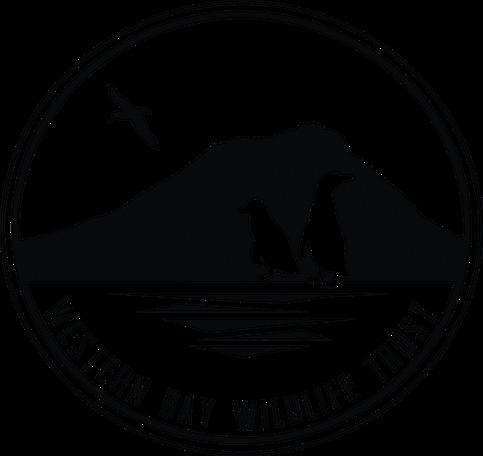

Western Bay Wildlife Trust (WBWT) is a community-led conservation group that primarily focuses on protecting native seabird and shorebird species and their habitats in the Western Bay of Plenty Region.
Our diverse work includes threatened species monitoring, habitat monitoring, predator control efforts, and little blue penguin (kororā) rescue and rehabilitation. We work closely with our local community, raising awareness for our local sea and shorebird populations, and nurturing the next generation of conservationists to continue protecting New Zealand’s incredible biodiversity. Each year we run education days, working bees, and organise volunteers for pest control and planting.
Our monitoring work is mostly focused around Mauao (Mount Maunganui), Moturiki (Leisure Island), and Mount Maunganui Beach where we gather information about kororā (little blue penguin), ōi (grey-faced petrel), tūturiwhatu (northern New Zealand Dotterel), and torea pango (variable oystercatcher).
2023 - A GREAT YEAR FOR OUR KORORĀ COLONIES
The change to the “El Nino” weather pattern has been a game changer for our blue feathered friends. More food close to shore enabled them to feed closer to their breeding colonies. That means that our breeding birds are finally back to, or above average weight range, (900 grams to 1 kg), which ensures that their chicks are well-
www.westernbaywildlife.nz
westernbaywildlife@gmail.com
Socials: @westernbaywildlifetrust
Map Reference: Page 10
fed and given the best chances possible.
Apart from our conservation mahi, our founding trustees Julia and Paul contributed and starred in Taking Back our Beach, which is a documentary paying tribute to our community that came together after the MV Rena oil spill and helping save the beach and its wildlife. This has been a humble reminder to our roots as a trust, as well as a motivator to continue to remind people about the amazing biodiversity in our backyard, and the need for us to protect it.
We also held a presentation at the Oamaru Penguin Symposium, called Kororā conservation in the Bay of Plenty.
During the year the Weather and Climate Journal publish some of our research as part of the Marine Ecosystem impacts of summer heatwaves”paper.
GET INVOLVED!
Donate!
We are a registered charity and rely heavily on donations to fund our vital conservation work. Any contribution is hugely appreciated and directly supports our activities.
Volunteer
If you are local and like to go the extra mile, volunteer with us! Head to the Get Involved tab on our website to find out more.

IF YOU SEE A SICK OR INJURED PENGUIN PLEASE CALL: 0800 Sick Penguin (0800 742 573)

Or scan the code & message our Facebook page: @westernbaywildlifetrust
To minimize stress for the penguinor any sick/injured wildlife, make sure to keep domestic pets and/or children away from them and be as quiet as possible.
TOP: In April a fantastic crew of volunteers helped us remove 29.7 kg of rubbish and pull out pest plants off Moturiki (Leisure Island).
ABOVE RIGHT: Trust co-founder Paul Cuming featured in the documentary ‘Taking Back Our Beach’ .
50 WWW.BAYCONSERVATION.NZ P 07 808 0710
NEWS FROM WESTERN BAY WILDLIFE TRUST
Bay Conservation Incorporated
End of Year Report For the 12 months ended 31 December 2023
STATEMENT OF FINANCIAL PERFORMANCE
NOTES
1. Surplus or deficits shown have been impacted by no adjustments to carry over income received in advance. Funds income received in advance shows as large funds at bank.
2. Bay Conservation Alliance financial year ends 30 June, these accounts have been prepared for inclusion in this calendar report only.
3. The basis for measurement in these accounts is Historical Cost.
4. These financial statements have not been audited.
LOOKING BACK ON 2023 51
INCOME Fundraising Grants Donations Membership Other Income TOTAL INCOME EXPENSES Education and Event Delivery Contractors and Consultants Wages Other expenses TOTAL EXPENSES 31 DECEMBER 2023 31 DECEMBER 2022 1,152,472 1,045,859 45,000 60,000 25,080 5,862 2,400 2,300 23,027 4,282 1,247,979 1,118,303 75,326 54,969 366,795 419,908 555,294 472,709 221,894 121,810 1,219,309 1,069,396 SURPLUS (Deficit) (Note 1) 28,670 48,907 STATEMENT OF FINANCIAL POSITION $ $ 31 DECEMBER 2023 31 DECEMBER 2022 $ $ CURRENT ASSETS Cash at Bank (Note 1) Accounts Receivable GST TOTAL CURRENT ASSETS NON CURRENT ASSETS Property Plant & Equipment TOTAL ASSETS CURRENT LIABILITIES Accounts Payable Provision for Annual Leave GST Income in advance TOTAL CURRENT LIABILITIES NET ASSETS 592,416 426,973 69,000 230 0 0 42,538 61,024 2,278 4,749 20,053 16,587 17,239 9,974 187,818 0 703,954 488,227 661,416 427,203 227,387 476,567 456,917 31,310
TO FINANCIAL STATEMENTS
2023 FINACIAL REPORT
Ehara Taku toa i te toa takitahi, he toa takitini.
My strength is not as an individual, but as a collective.
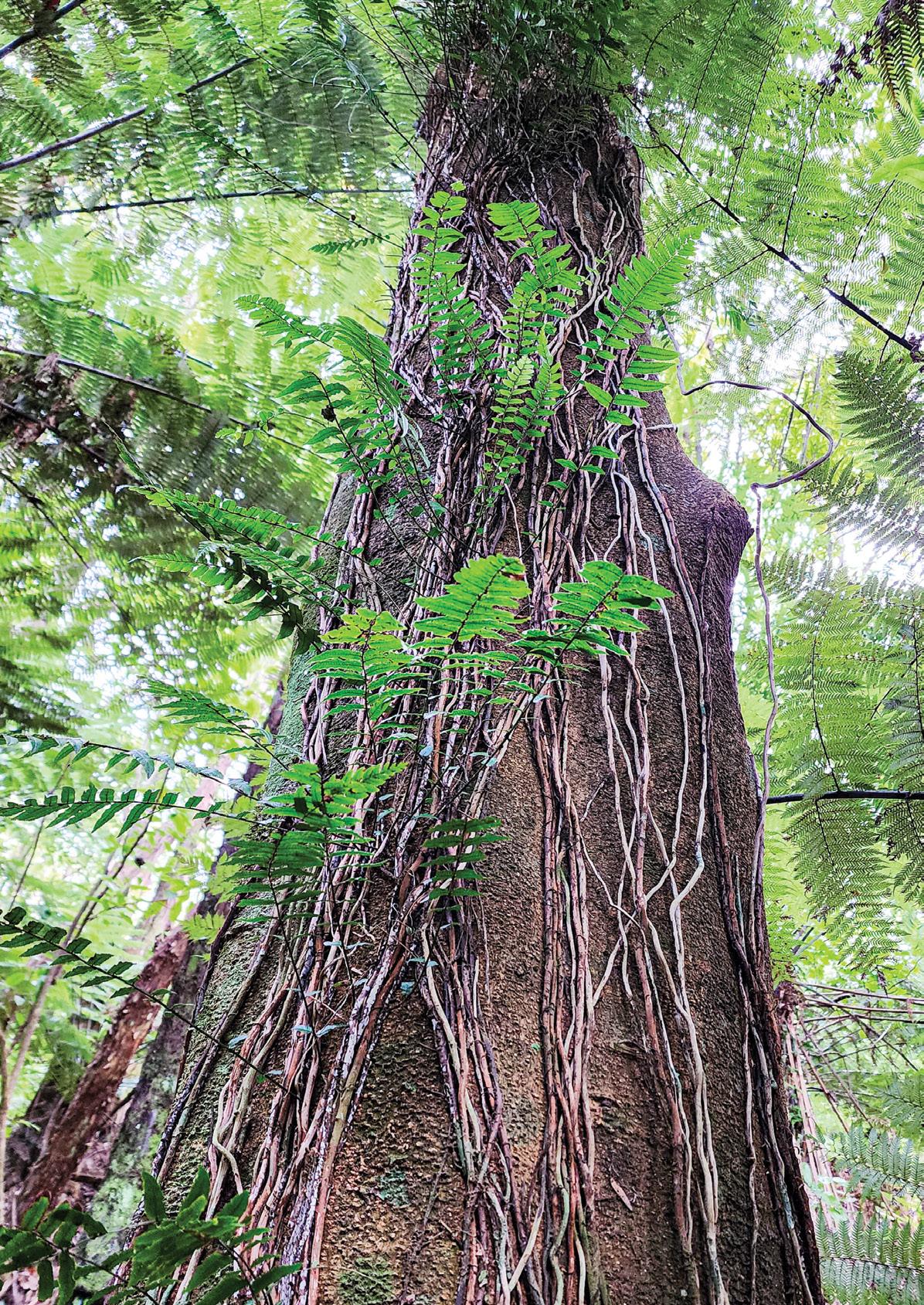
Investment in the Taiao (environment) and those working hard to support positive outcomes is crucial for economic, social, cultural and environmental well-being.
We would therefore like to acknowledge and thank these organisations who have played a huge part in the acheivements throughout 2023.
We will continue to grow our funding support base. If you would like to find out how you can contribute, please get in touch. Partnerships are key - join us today!
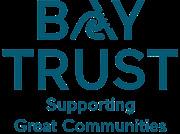




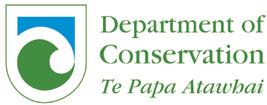




































































 Words: Clare Power
Words: Clare Power


















































































































